150+ AI Prompts for WordPress Devs [Get the Free PDF]

There’s no shortage of AI prompt lists claiming to supercharge your WordPress workflow. The internet is full of AI prompt ideas, from the official WordPress Core Development Repository and Gutenberg’s block editor project to community-driven resources like Senlin’s Code Snippets. But that also means it’s easy to fall into the “shiny toy” trap: chasing the latest AI prompt generators, threads, and hacks without getting anything done.
This is why we created a prompt library that houses nearly 200 AI prompts for WordPress developers and freelancers. Everything is cleanly organized by use case, whether you’re debugging code, customizing WooCommerce, developing plugins, or troubleshooting tricky client issues.
Just download it, plug it into your workflow, and build smarter.
3 Tips on Writing The Best AI Prompts
Before diving into the prompts, here’s a quick peek at how we wrote them — and how you can tweak them to fit your workflows. Here’s what matters when writing prompts that work:
1. Know Your AI Tool Options
Every AI tool responds a little differently because they’re built differently, and they access different data. Before you pick one, it’s worth exploring your options: ChatGPT, Claude, Mistral, and others.
For this prompt library, we used ChatGPT. But you can easily try the same prompts with models like Llama 3, Gemini 1.5 Flash, or even open-source LLMs like Bloom or Falcon. Sometimes, mixing tools might get you closer to the output you want.
2. Be Specific with Details
WordPress developers know that the more detailed your instructions, the better the output. Instead of asking for “a custom post type plugin,” our prompt spells everything out:
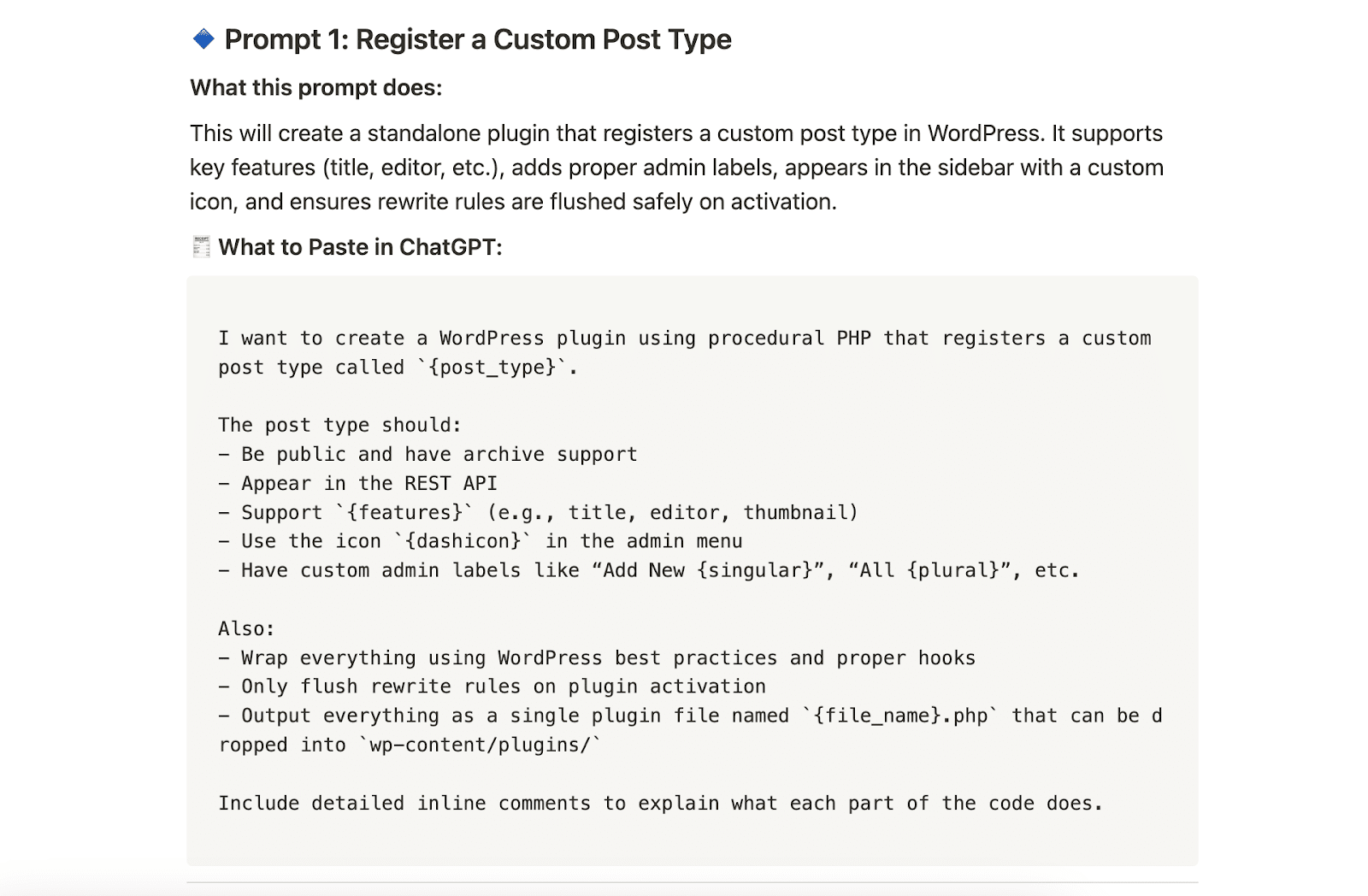
It even includes best practices like hook usage and flushing rewrite rules only on activation.
By providing this level of detail about your requirements, file naming conventions, and even requesting inline documentation, you give AI tools everything they need to generate production-ready code that meets professional WordPress development standards.
3. Be Clear
If your prompt is vague, your output will be too. Here’s one of the prompts from the library.

The prompt identifies the WordPress admin login issue without unnecessary elaboration. It also explicitly asks for potential causes and debugging approaches, giving the AI clear direction.
This clarity ensures the AI can provide targeted, actionable advice rather than generic troubleshooting steps. For WordPress professionals, this kind of precise communication with AI tools can speed up problem resolution and reduce development bottlenecks.
AI Prompt Examples (From the PDF)
Enough theory. Now, let’s see what this looks like. Here are a few AI prompts from the library and the expected output.
Category: Headless WordPress & REST API
AI Prompt Example #1: Create a Custom REST API Endpoint
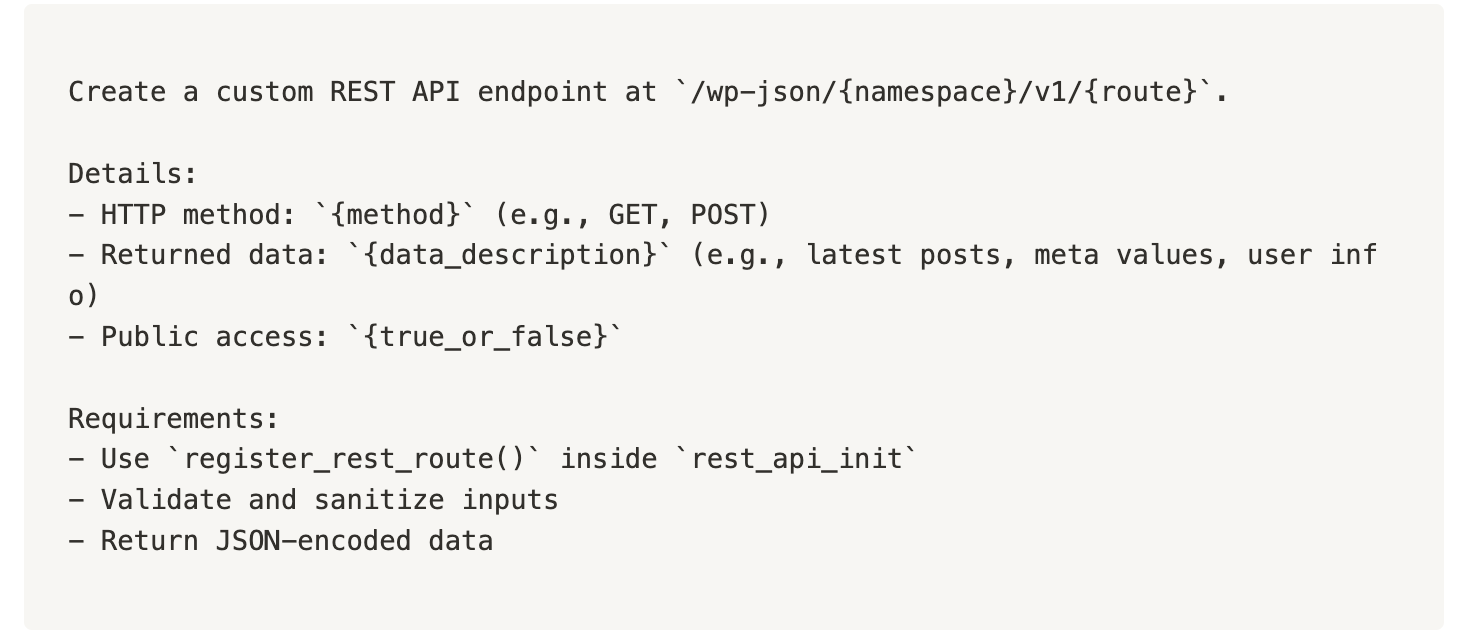
Output:
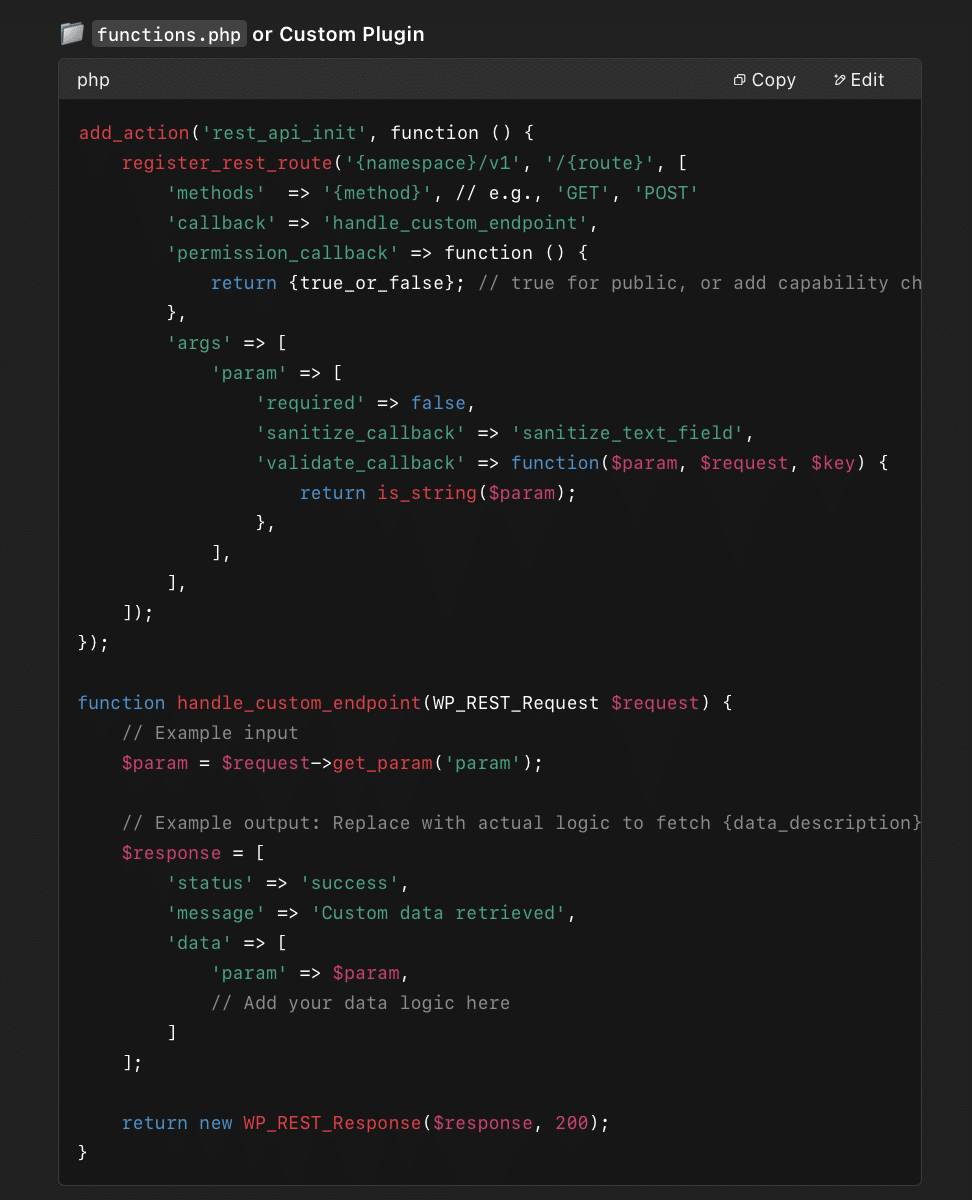
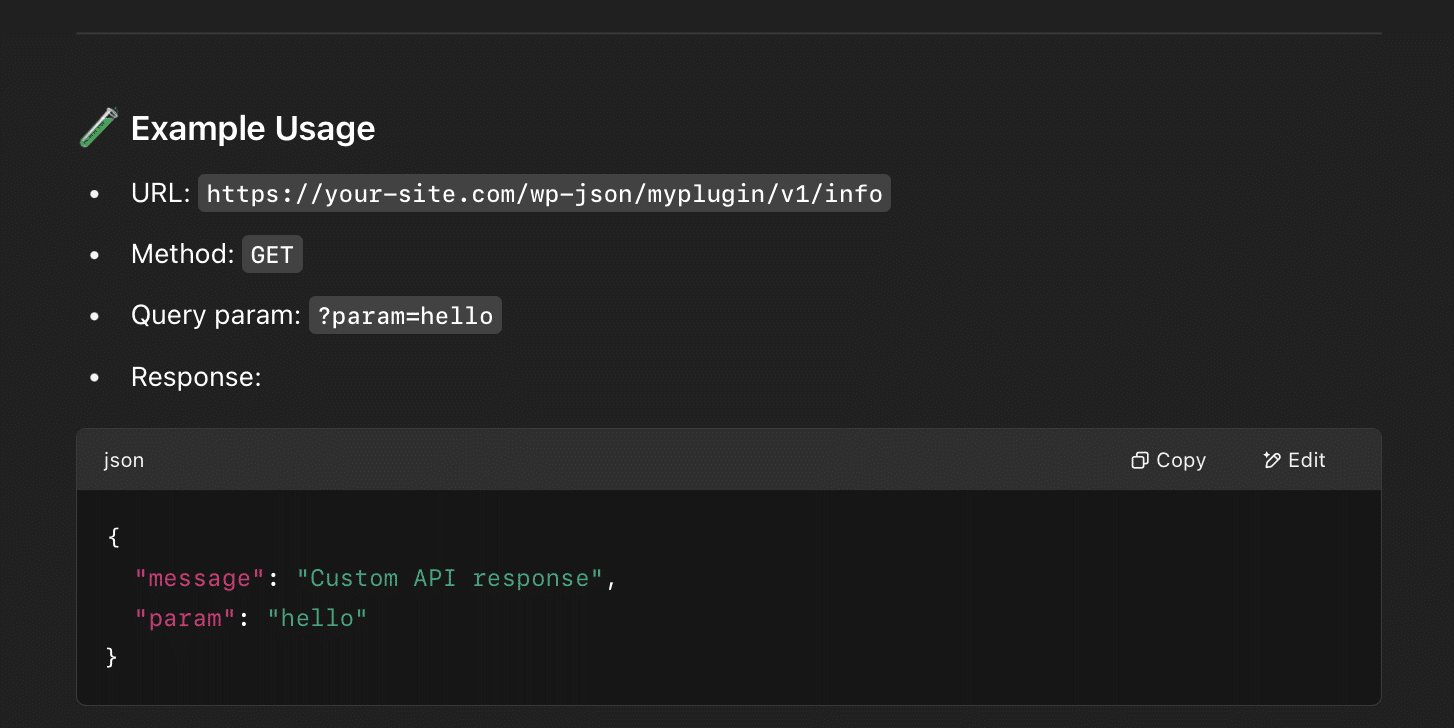
Category: Plugin Development Prompts
AI Prompt Example #2: Register a Custom Post Type
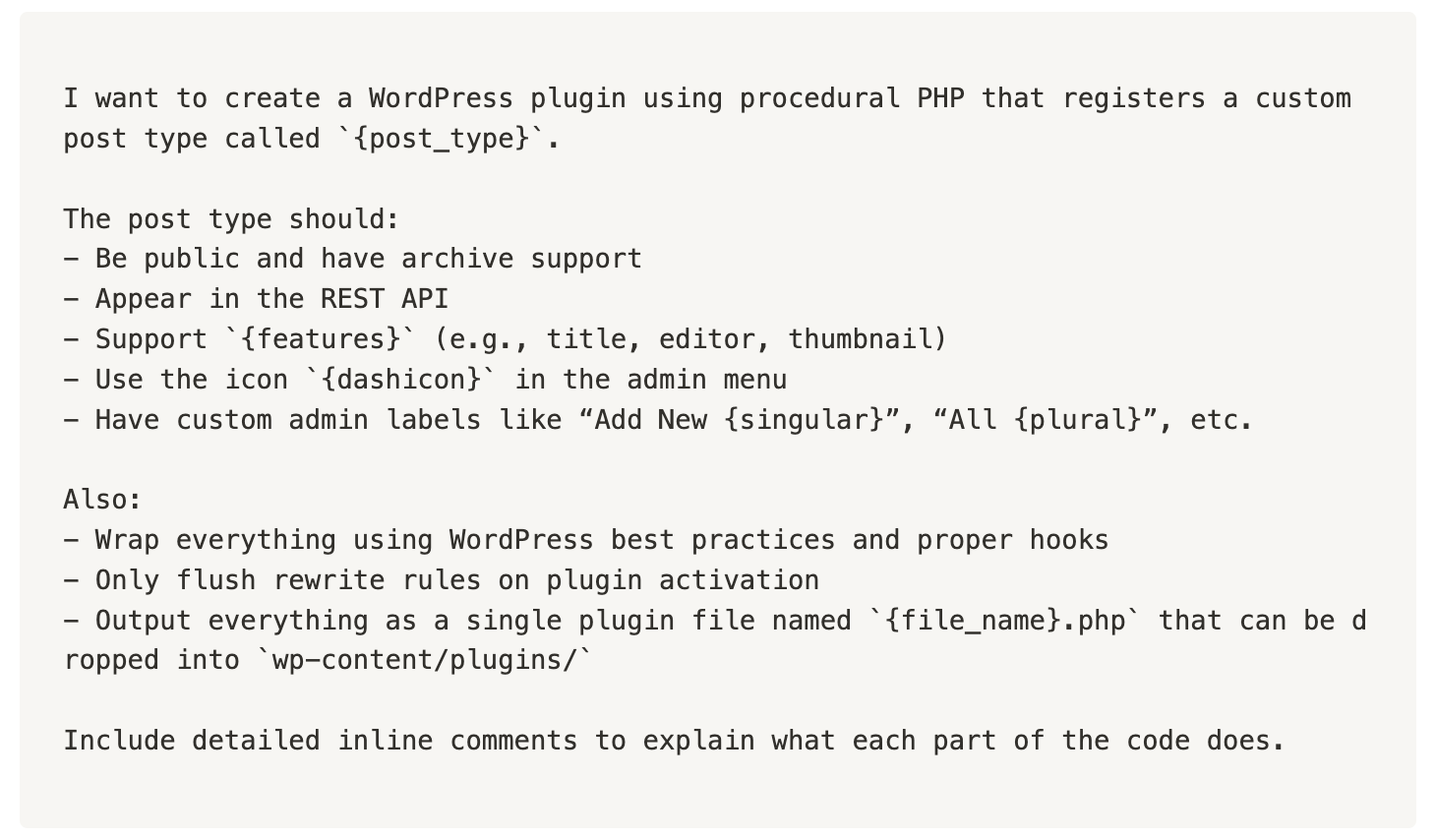
Output:
<?php
/**
* Plugin Name: Custom Post Type - {post_type}
* Description: Registers a custom post type called {post_type}.
* Version: 1.0
* Author: Your Name
*/
// Exit if accessed directly
if ( ! defined( 'ABSPATH' ) ) {
exit;
}
/**
* Registers the custom post type.
*/
function register_custom_post_type_{post_type}() {
$labels = array(
'name' => _x( '{plural}', 'Post type general name', 'textdomain' ),
'singular_name' => _x( '{singular}', 'Post type singular name', 'textdomain' ),
'menu_name' => _x( '{plural}', 'Admin Menu text', 'textdomain' ),
'name_admin_bar' => _x( '{singular}', 'Add New on Toolbar', 'textdomain' ),
'add_new' => __( 'Add New {singular}', 'textdomain' ),
'add_new_item' => __( 'Add New {singular}', 'textdomain' ),
'new_item' => __( 'New {singular}', 'textdomain' ),
'edit_item' => __( 'Edit {singular}', 'textdomain' ),
'view_item' => __( 'View {singular}', 'textdomain' ),
'all_items' => __( 'All {plural}', 'textdomain' ),
'search_items' => __( 'Search {plural}', 'textdomain' ),
'not_found' => __( 'No {plural} found.', 'textdomain' ),
'not_found_in_trash' => __( 'No {plural} found in Trash.', 'textdomain' ),
'featured_image' => _x( 'Featured Image', '{singular}', 'textdomain' ),
'set_featured_image' => _x( 'Set featured image', '{singular}', 'textdomain' ),
'remove_featured_image' => _x( 'Remove featured image', '{singular}', 'textdomain' ),
'use_featured_image' => _x( 'Use as featured image', '{singular}', 'textdomain' ),
'archives' => _x( '{singular} Archives', 'textdomain' ),
'insert_into_item' => _x( 'Insert into {singular}', 'textdomain' ),
'uploaded_to_this_item' => _x( 'Uploaded to this {singular}', 'textdomain' ),
);
$args = array(
'labels' => $labels,
'public' => true, // Makes it publicly visible
'has_archive' => true, // Enables post type archives
'show_in_rest' => true, // Enables Gutenberg and REST API
'menu_icon' => '{dashicon}', // Dashicon icon slug
'supports' => array( {features} ), // Features like title, editor, thumbnail, etc.
'rewrite' => array( 'slug' => '{post_type}' ), // Custom URL slug
);
register_post_type( '{post_type}', $args );
}
add_action( 'init', 'register_custom_post_type_{post_type}' );
/**
* Flush rewrite rules on plugin activation.
* This ensures proper permalink structure for the new post type.
*/
function activate_custom_post_type_{post_type}() {
register_custom_post_type_{post_type}(); // Register post type on activation
flush_rewrite_rules(); // Flush rewrite rules
}
register_activation_hook( __FILE__, 'activate_custom_post_type_{post_type}' );
/**
* Do NOT flush rewrite rules on deactivation (optional)
*/
function deactivate_custom_post_type_{post_type}() {
// No flush here to avoid unnecessary performance hit
}
register_deactivation_hook( __FILE__, 'deactivate_custom_post_type_{post_type}' );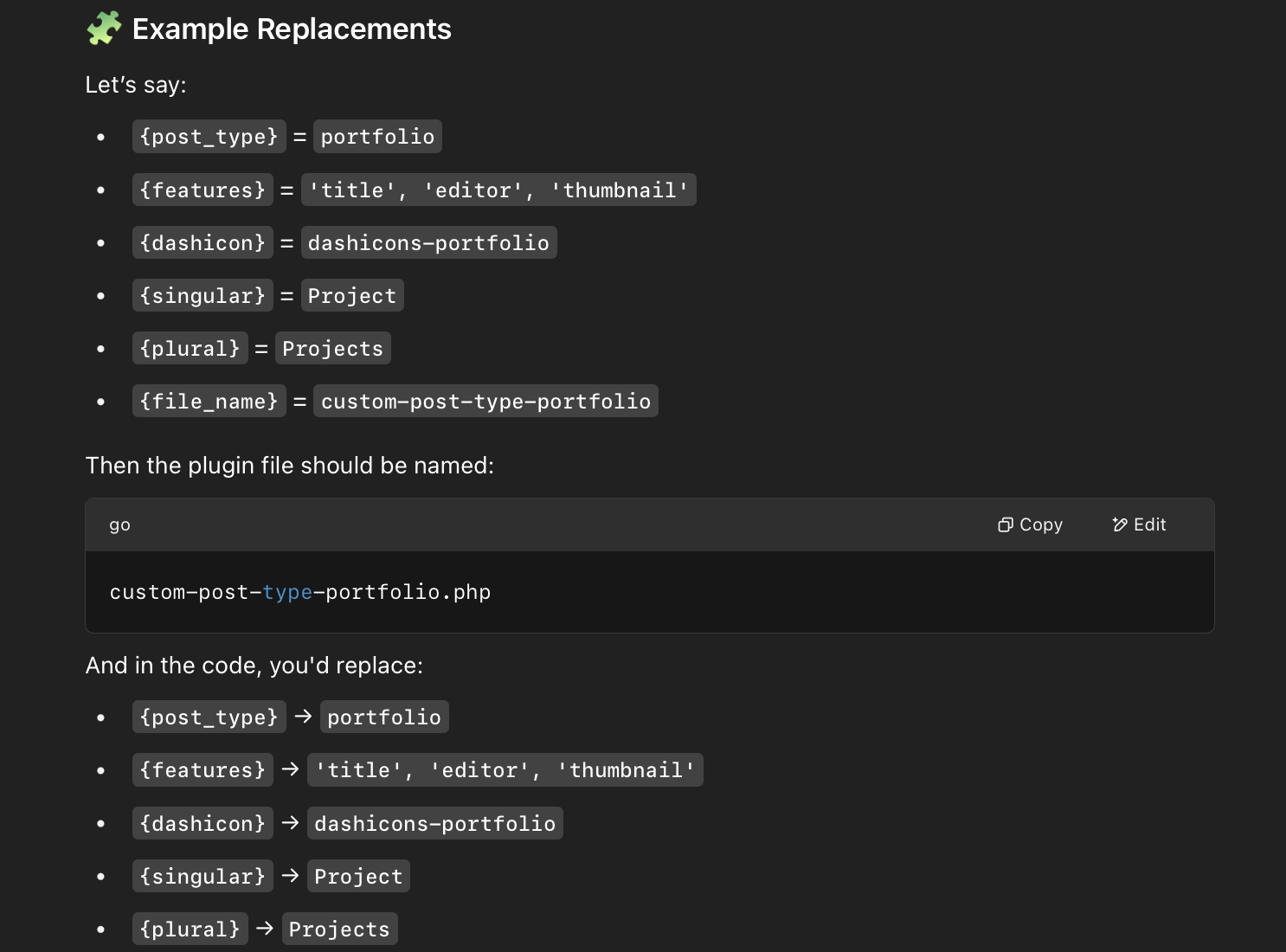
Category: Troubleshooting
AI Prompt Example #3: WordPress White Screen of Death

Output:
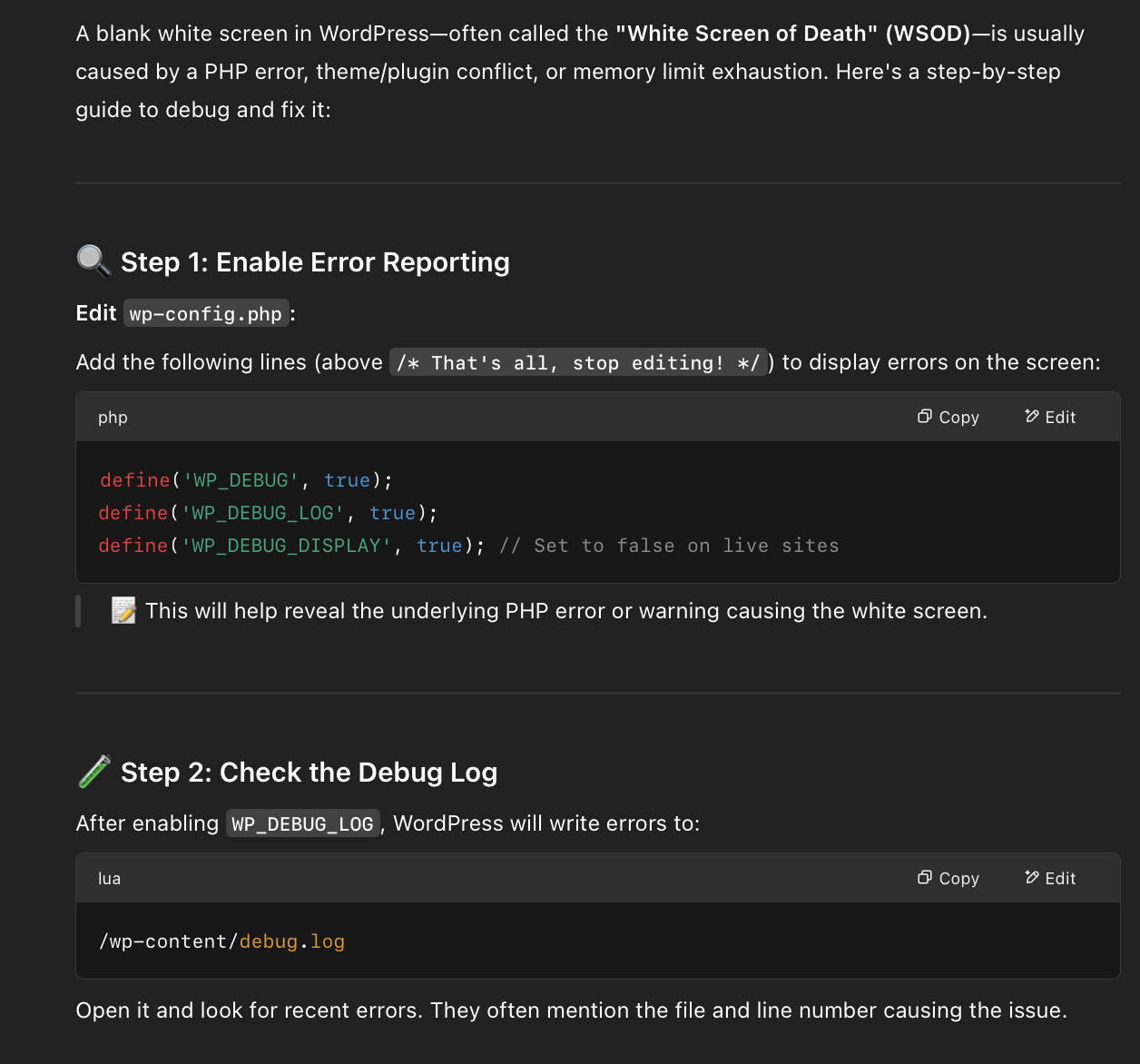
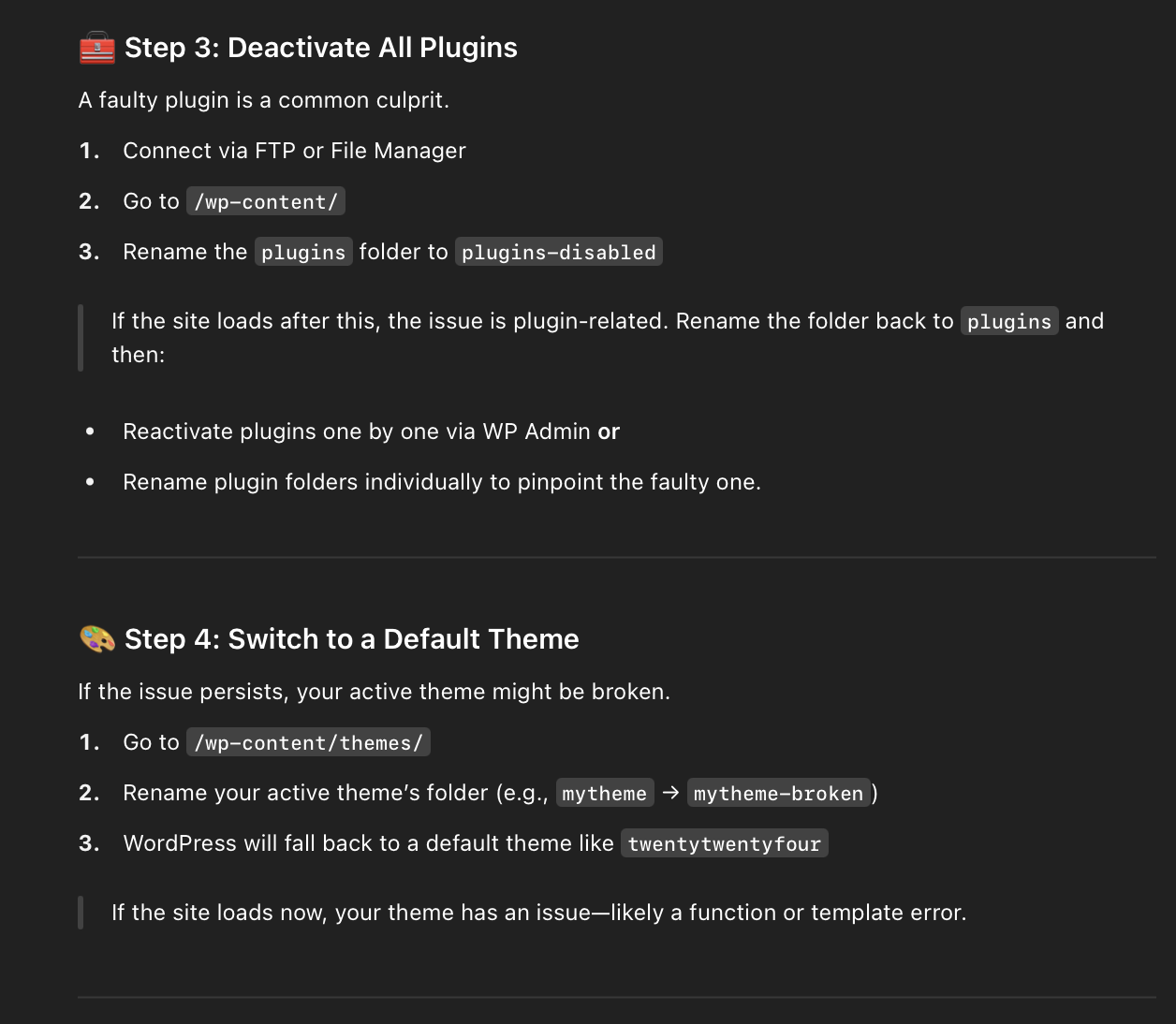
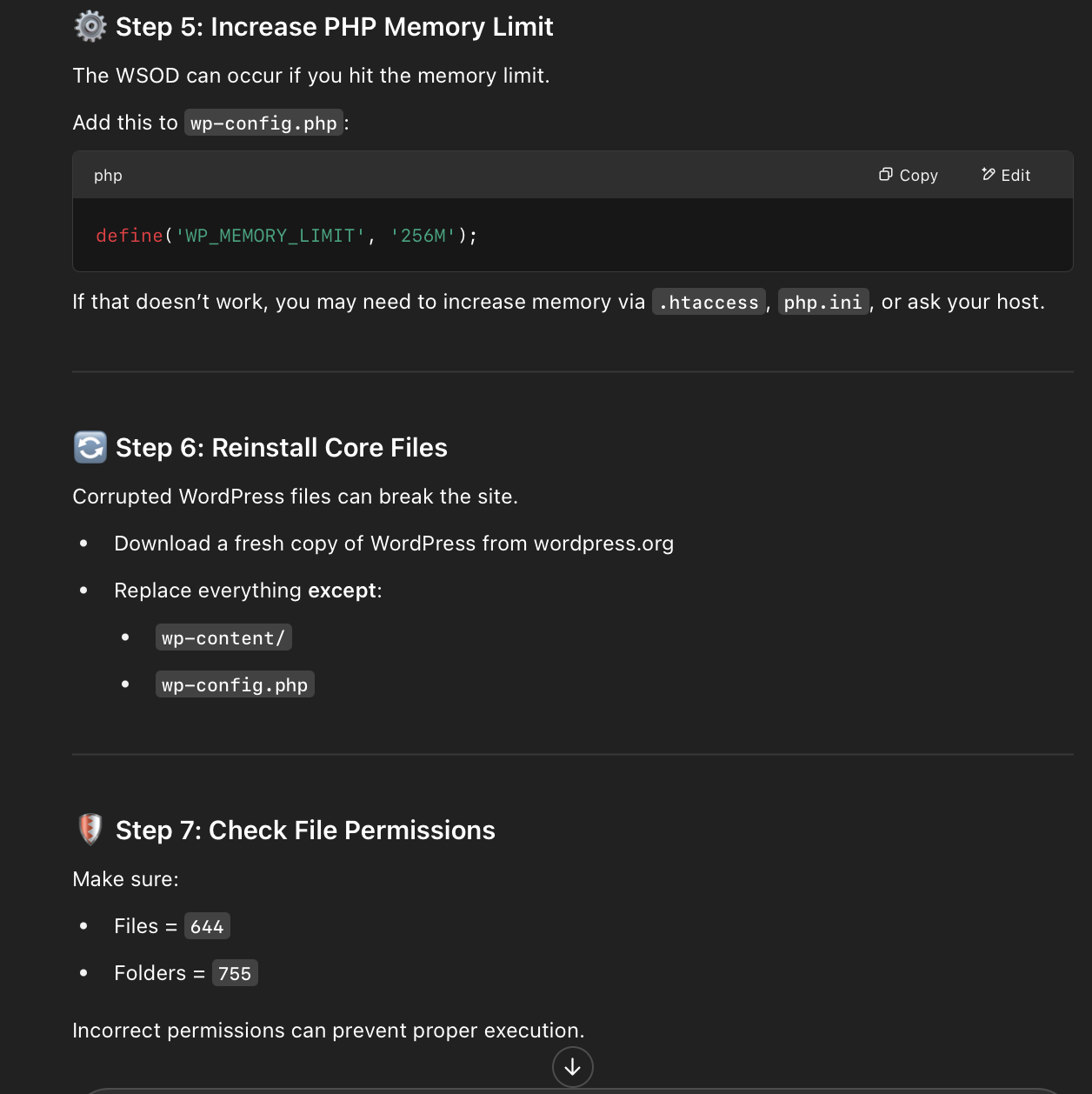

Category: Admin UI Customization
AI Prompt Example #4: Remove Dashboard Widgets
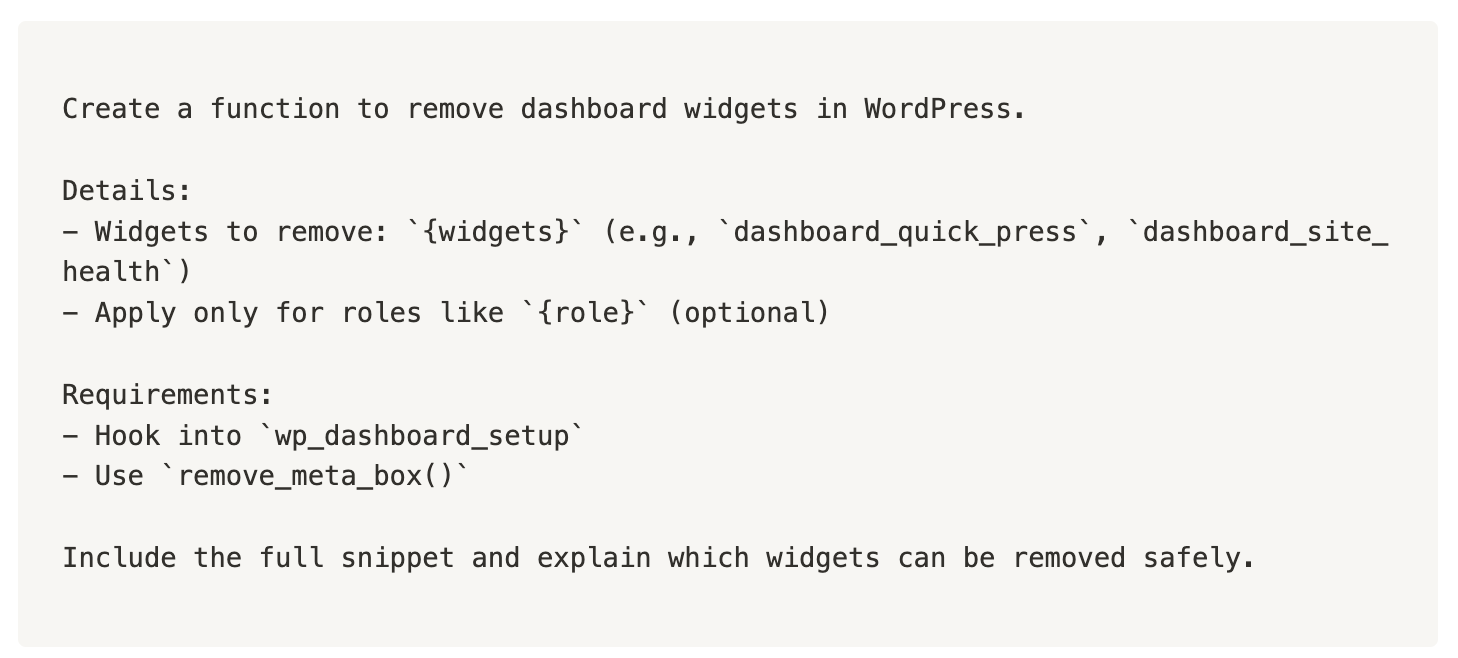
Output:
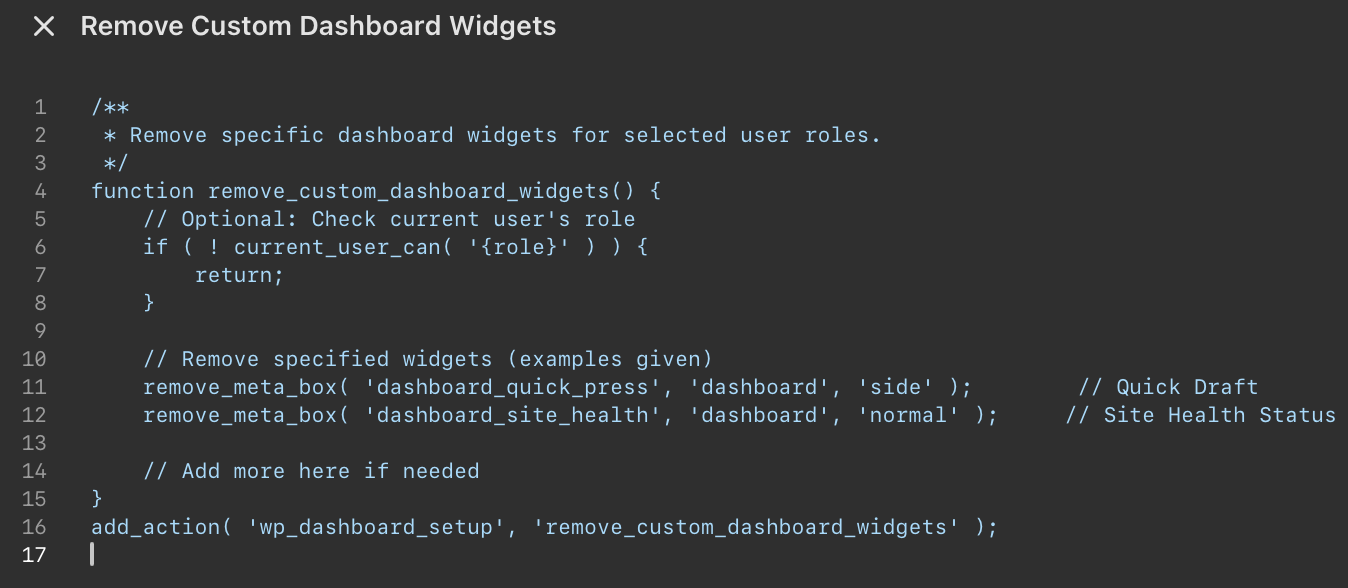
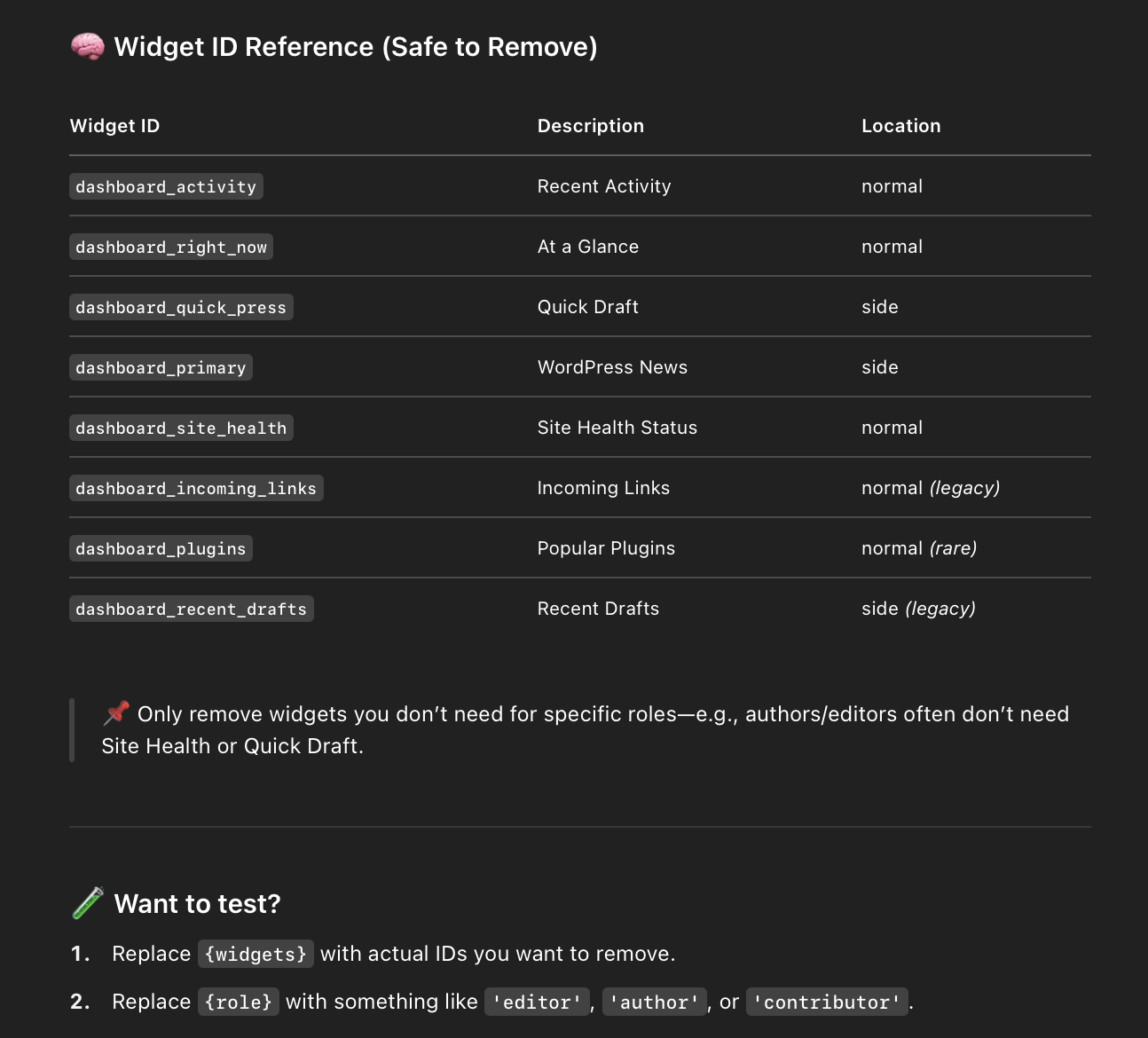
Category: Database & Query Optimization
AI Prompt Example #5: Add a Custom Index to the Postmeta Table
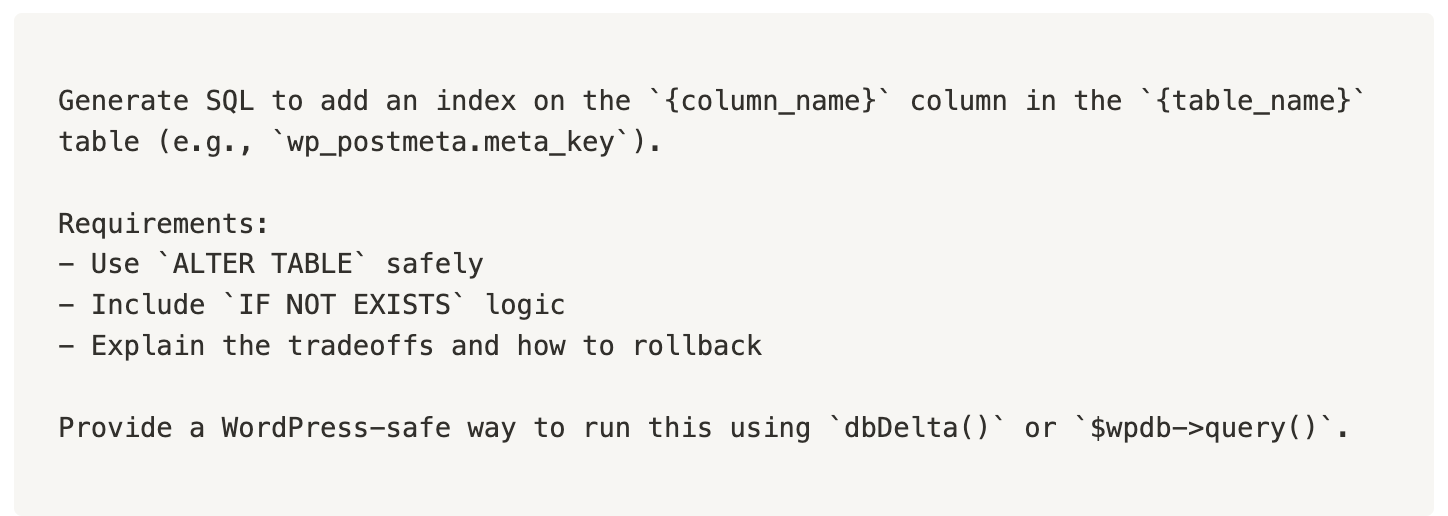
Output:
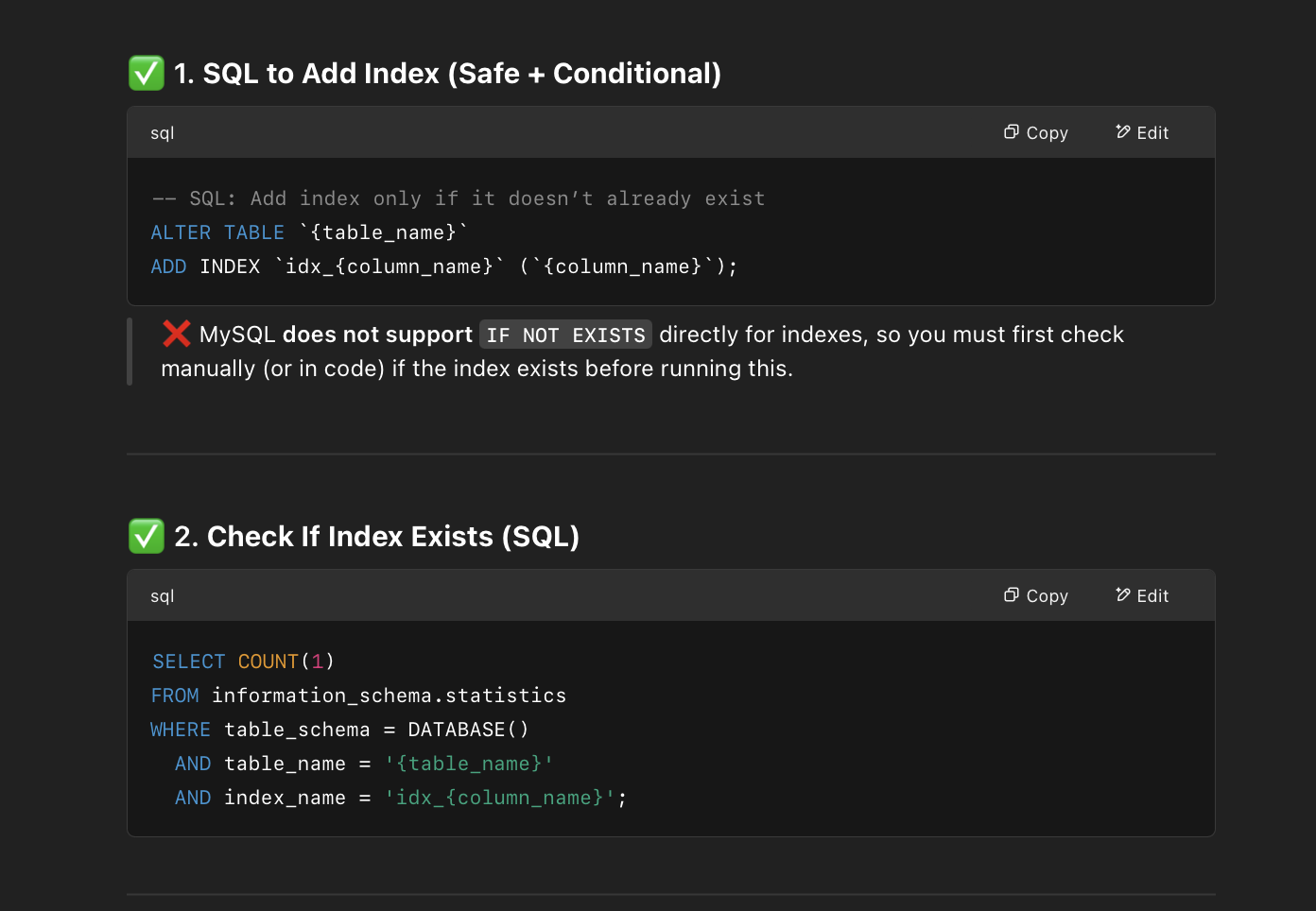
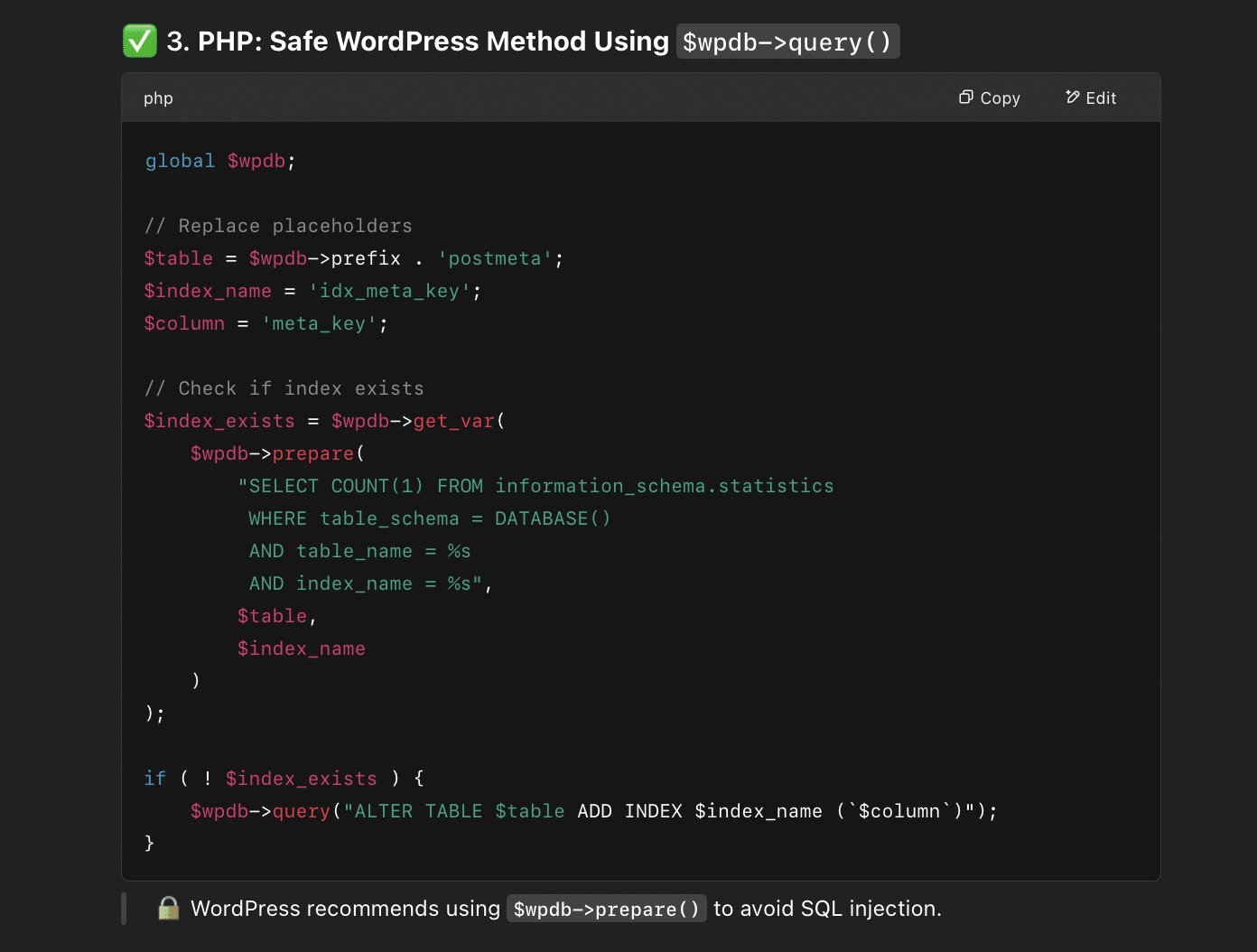
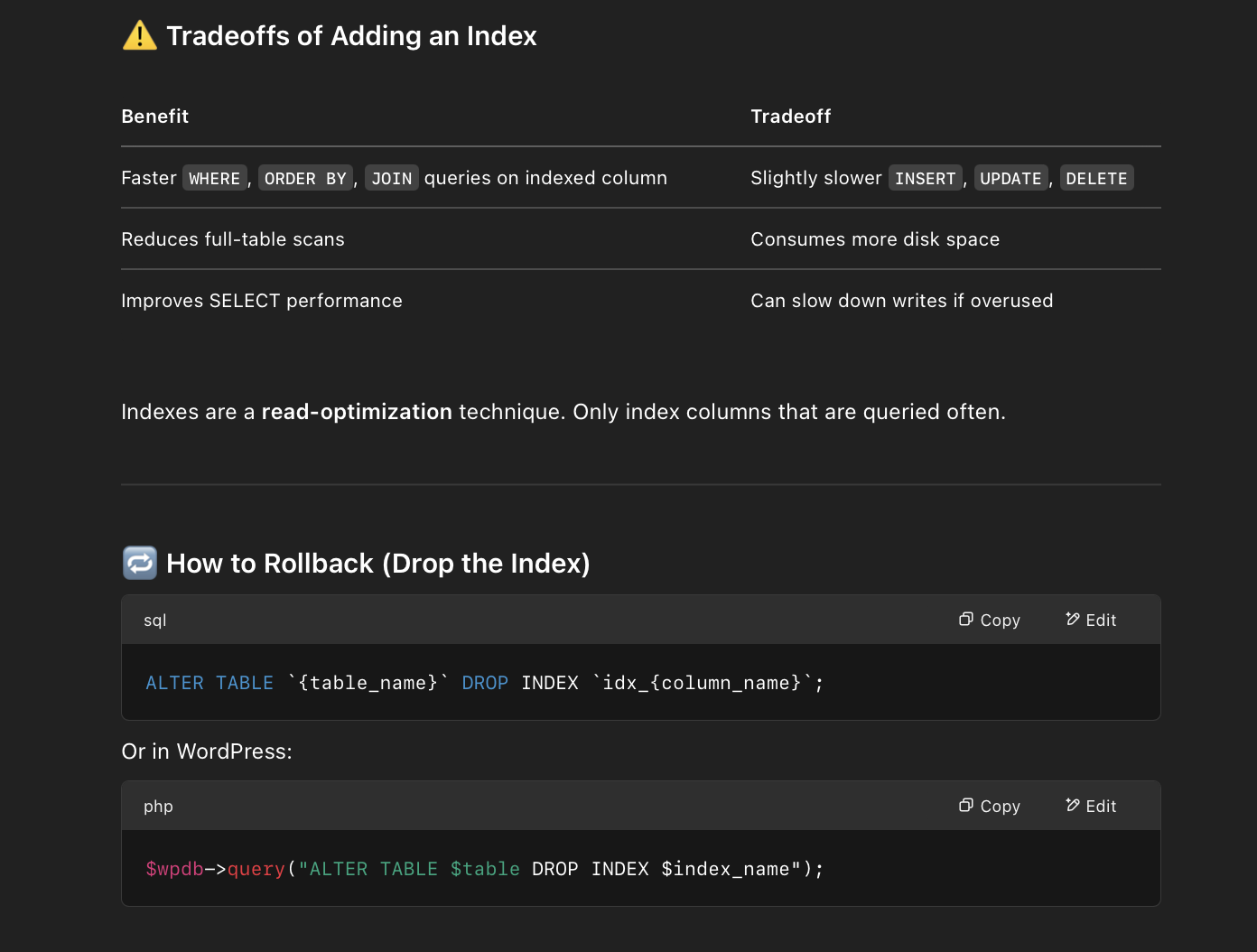

Get your copy of the Ultimate AI Prompts today and explore 100+ prompts across 10+ categories.
Category: Performance Optimization
AI Prompt Example #6: Disable Loading of Unused Block Styles
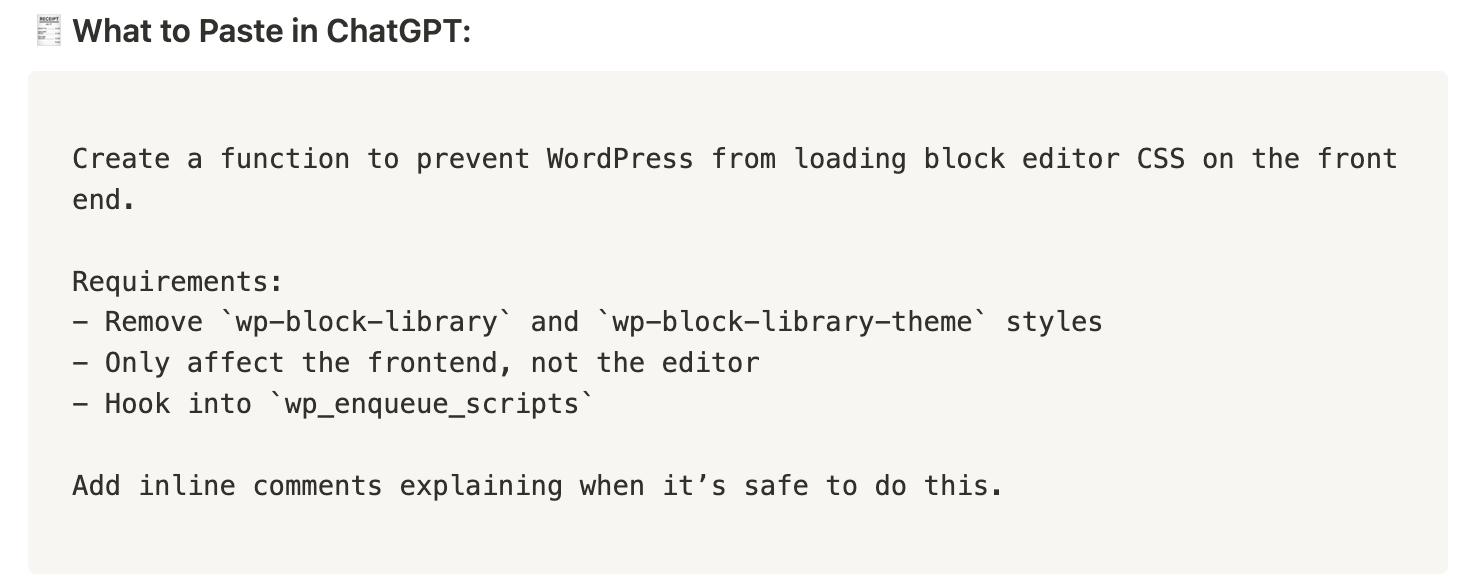
Output:
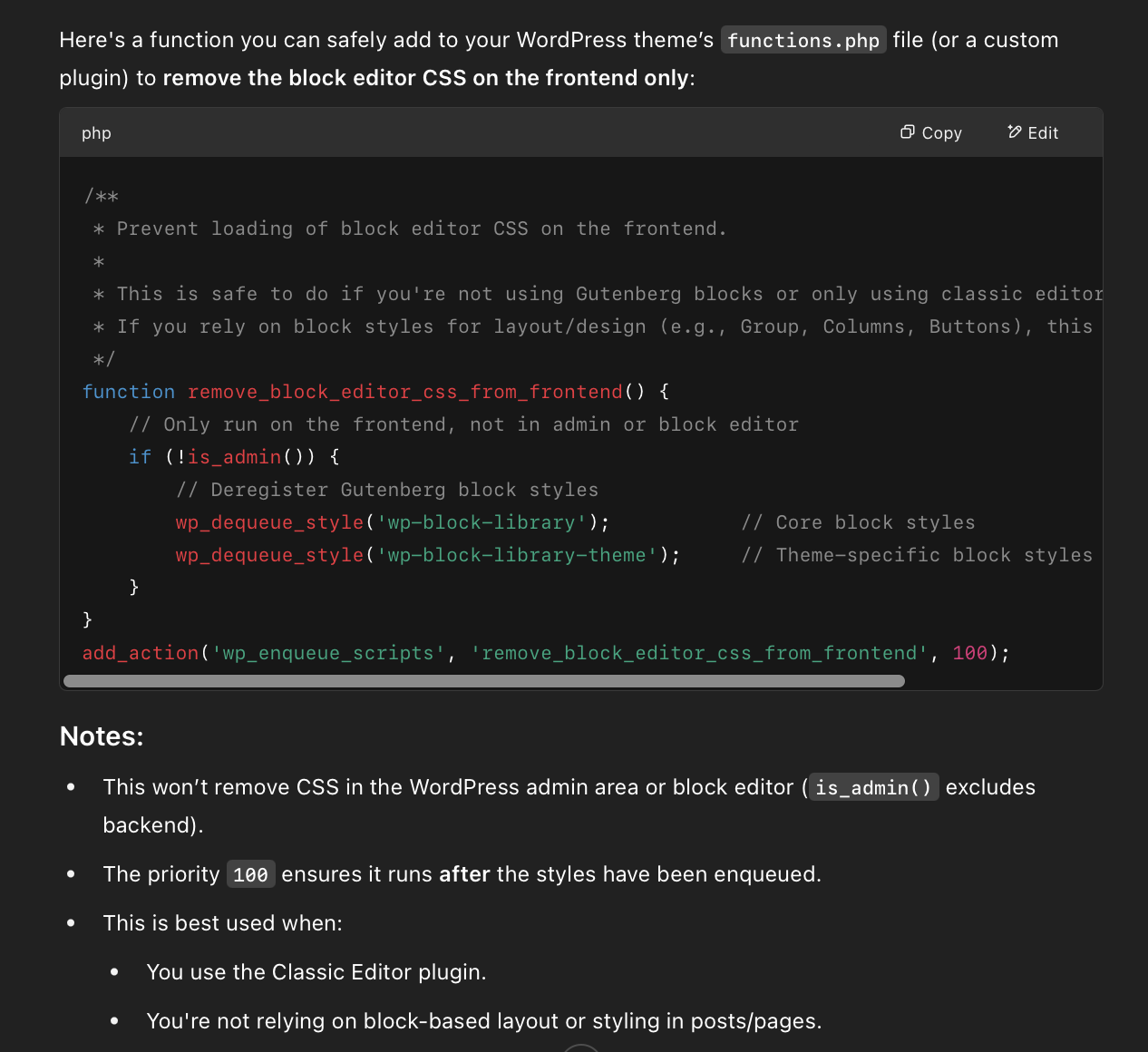
Category: Multisite
AI Prompt Example #7: Get a List of All Sites in a Network
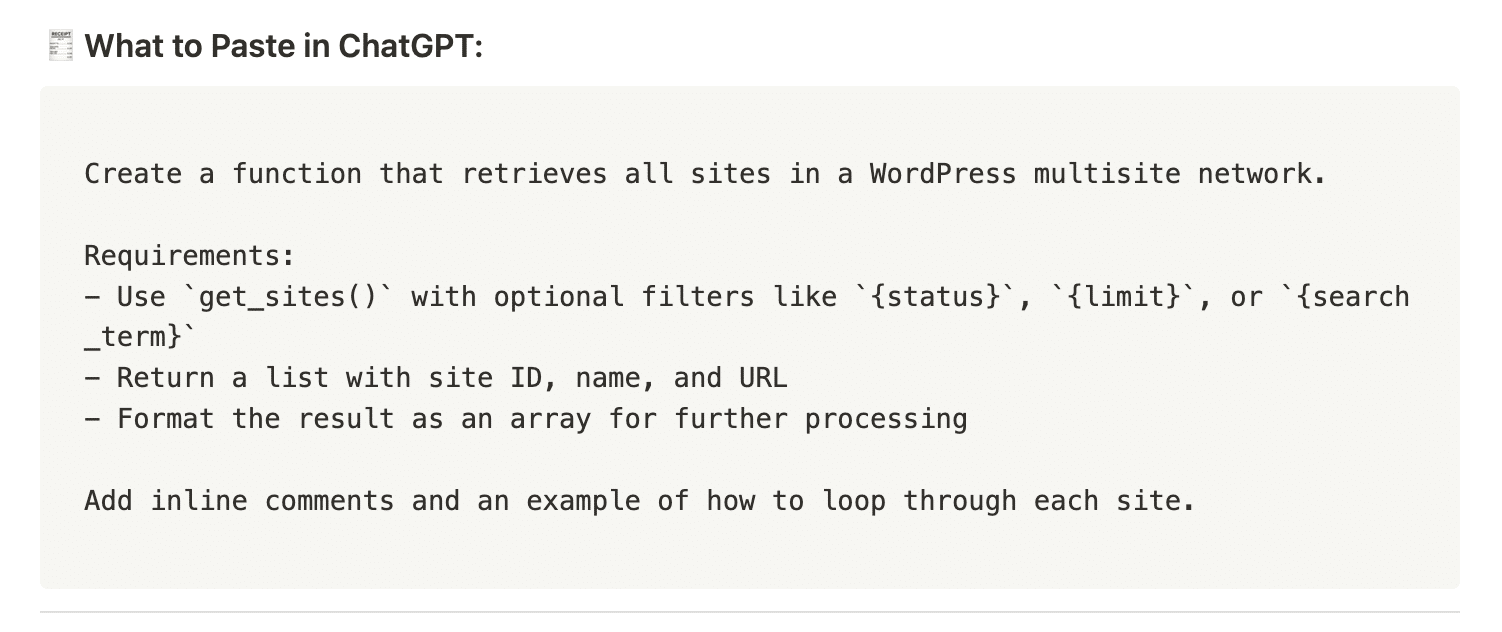
Output:
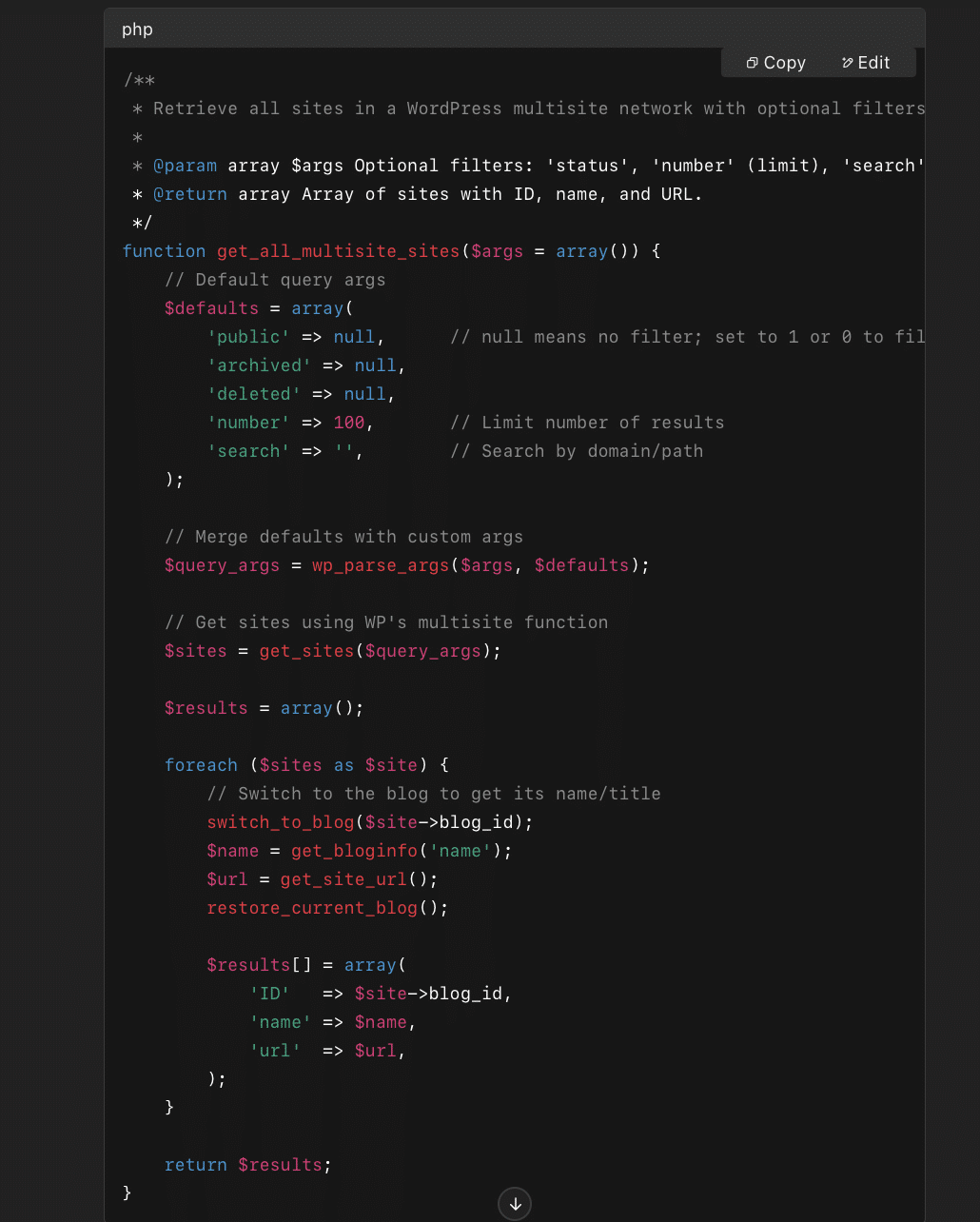
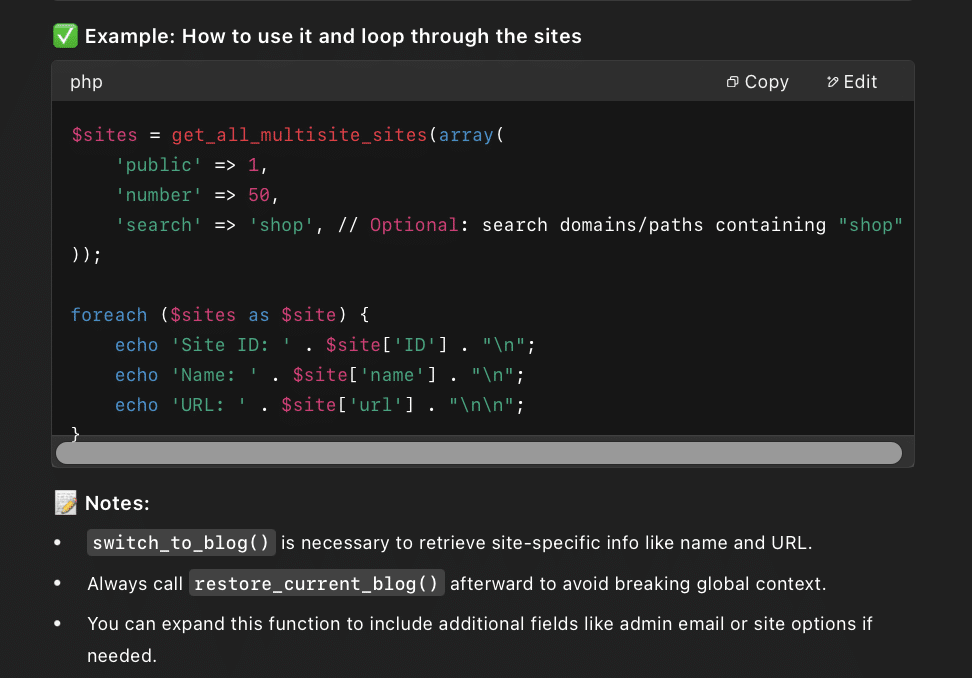
Category: WooCommerce Customizations
AI Prompt Example #8: Add a Custom Field to the Checkout Page
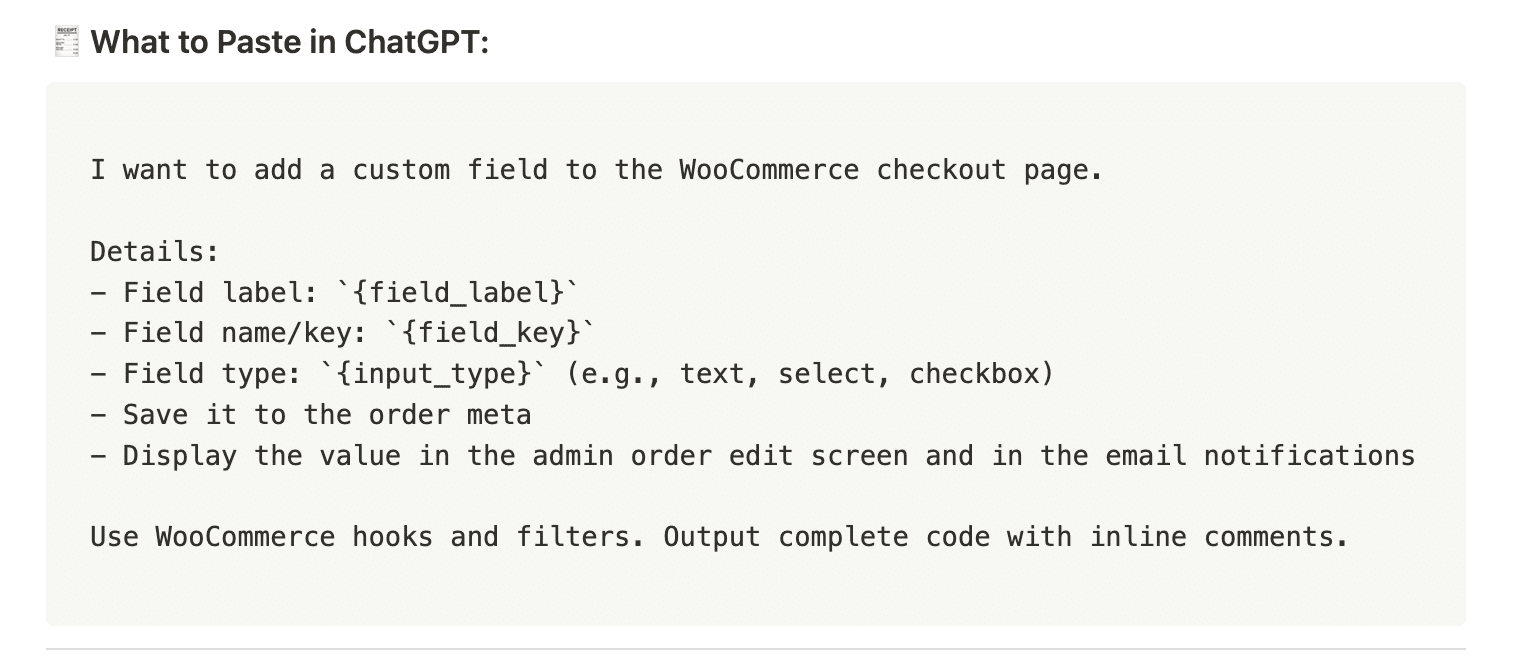
Output:
/**
* Add custom checkout field to WooCommerce.
*/
add_action('woocommerce_after_order_notes', 'custom_add_checkout_field');
function custom_add_checkout_field($checkout) {
echo '<div id="custom_checkout_field"><h3>Additional Information</h3>';
// Change values here based on your needs
woocommerce_form_field('{field_key}', array(
'type' => '{input_type}', // e.g., text, select, checkbox
'class' => array('form-row-wide'),
'label' => '{field_label}', // e.g., 'Gift Message'
'required' => false,
'options' => array( // Only used for select fields
'' => 'Please select',
'option_1' => 'Option 1',
'option_2' => 'Option 2',
),
), $checkout->get_value('{field_key}'));
echo '</div>';
}
/**
* Validate the custom field if needed (optional).
*/
add_action('woocommerce_checkout_process', 'custom_validate_checkout_field');
function custom_validate_checkout_field() {
if (isset($_POST['{field_key}']) && empty($_POST['{field_key}'])) {
// Uncomment below if field is required
// wc_add_notice(__('Please fill out the {field_label} field.'), 'error');
}
}
/**
* Save the field value to order meta.
*/
add_action('woocommerce_checkout_update_order_meta', 'custom_save_checkout_field');
function custom_save_checkout_field($order_id) {
if (isset($_POST['{field_key}'])) {
update_post_meta($order_id, '{field_key}', sanitize_text_field($_POST['{field_key}']));
}
}
/**
* Display field in admin order panel.
*/
add_action('woocommerce_admin_order_data_after_billing_address', 'custom_display_field_in_admin', 10, 1);
function custom_display_field_in_admin($order) {
$value = get_post_meta($order->get_id(), '{field_key}', true);
if ($value) {
echo '<p><strong>' . esc_html('{field_label}') . ':</strong> ' . esc_html($value) . '</p>';
}
}
/**
* Add custom field to order confirmation emails.
*/
add_filter('woocommerce_email_order_meta_fields', 'custom_add_field_to_emails');
function custom_add_field_to_emails($fields) {
$fields['{field_key}'] = '{field_label}';
return $fields;
}Category: ACF + Gutenberg Integration
AI Prompt Example #9: Register a Gutenberg Block Using ACF
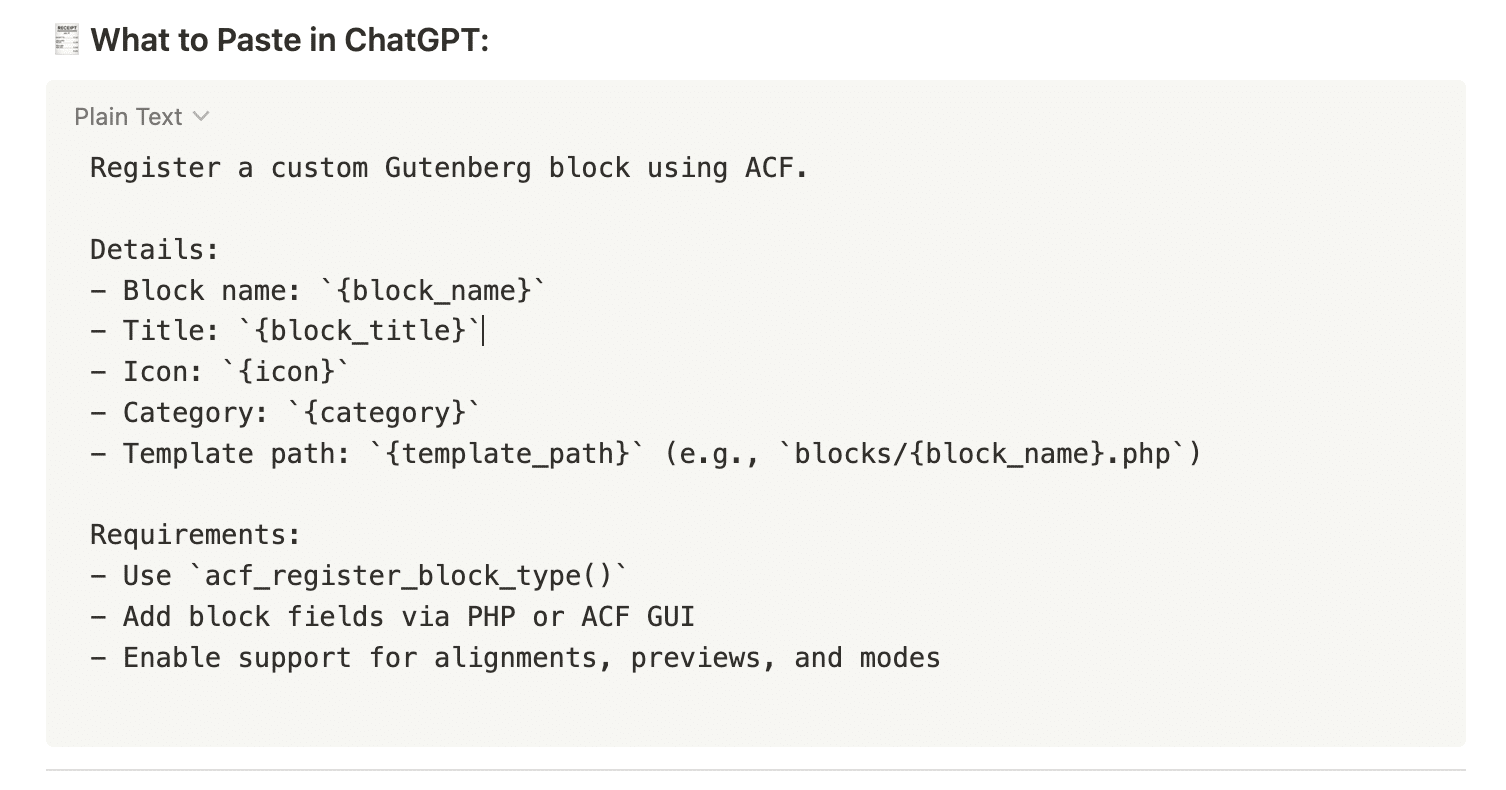
Output:
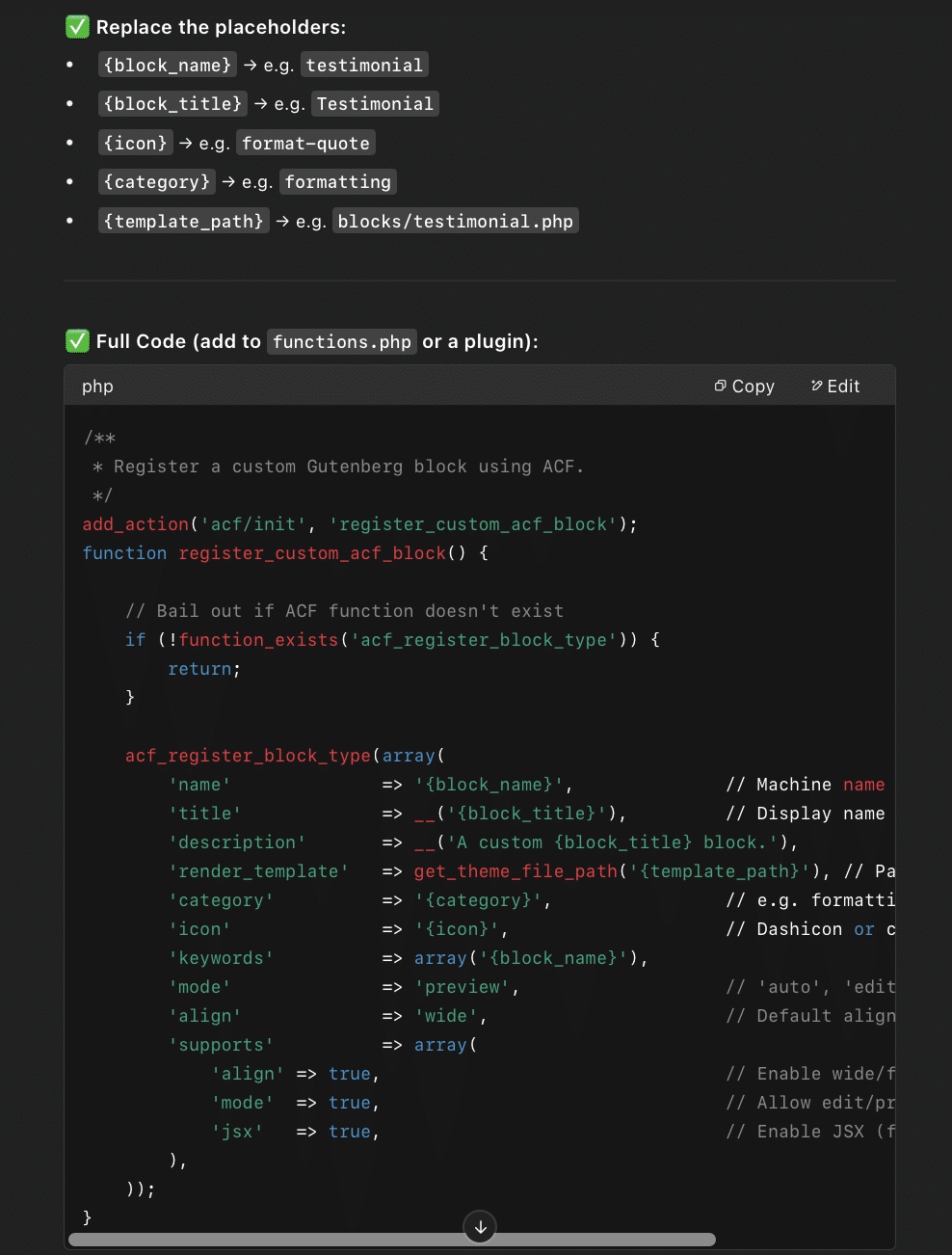
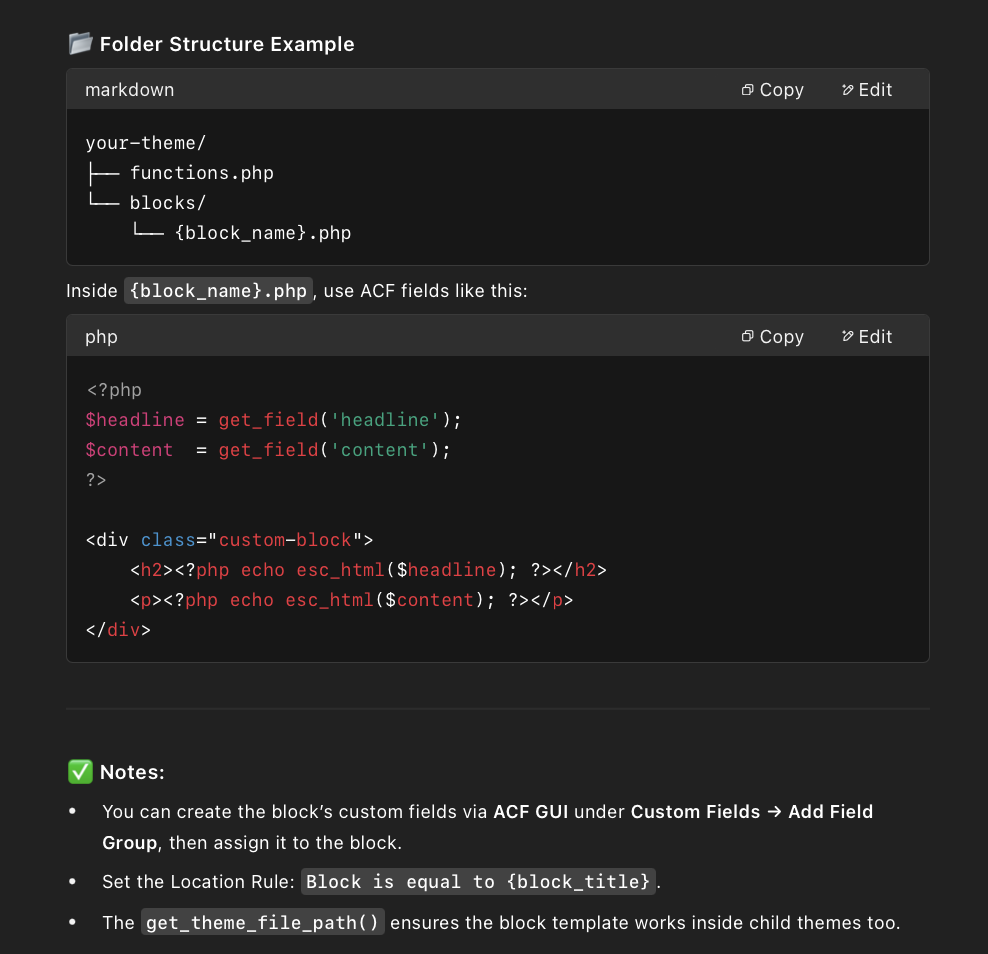
Category: Gutenberg & Block Editor
AI Prompt Example #10: Create a Static Gutenberg Block with block.json
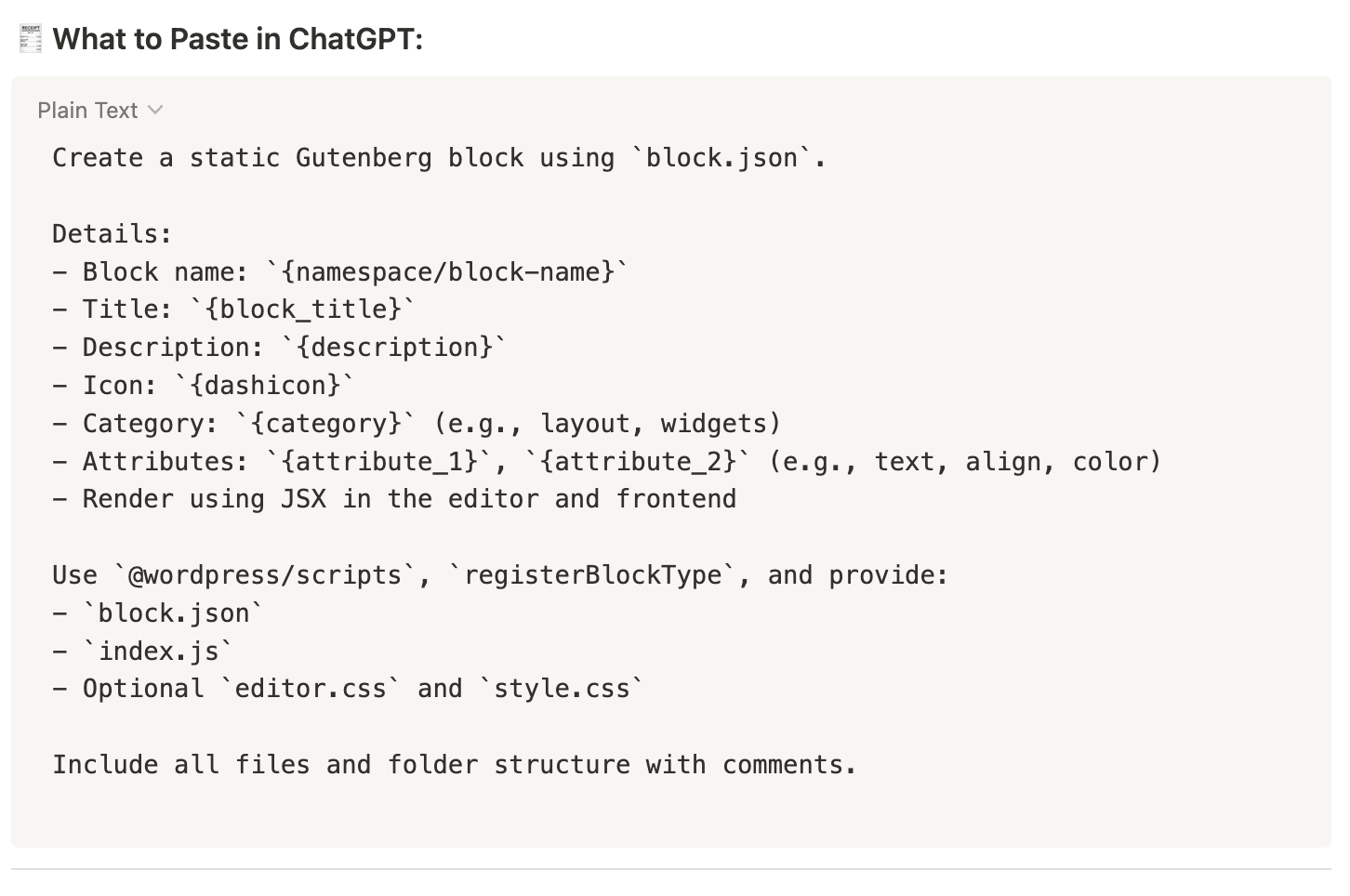
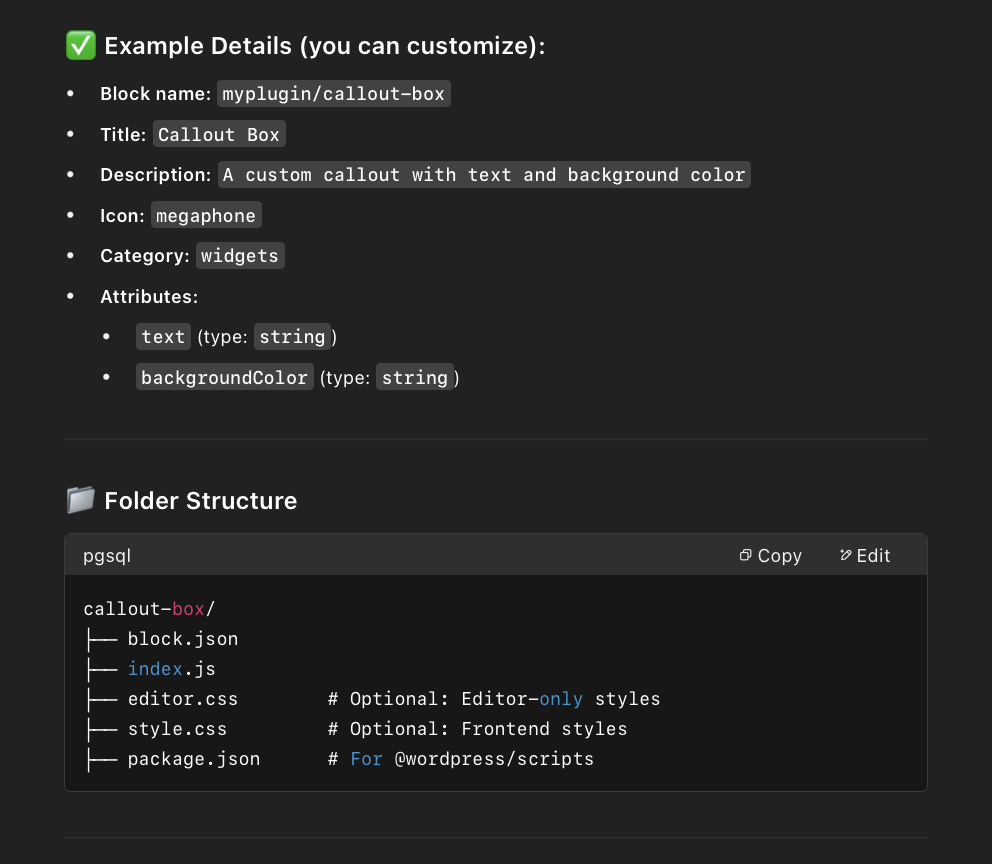
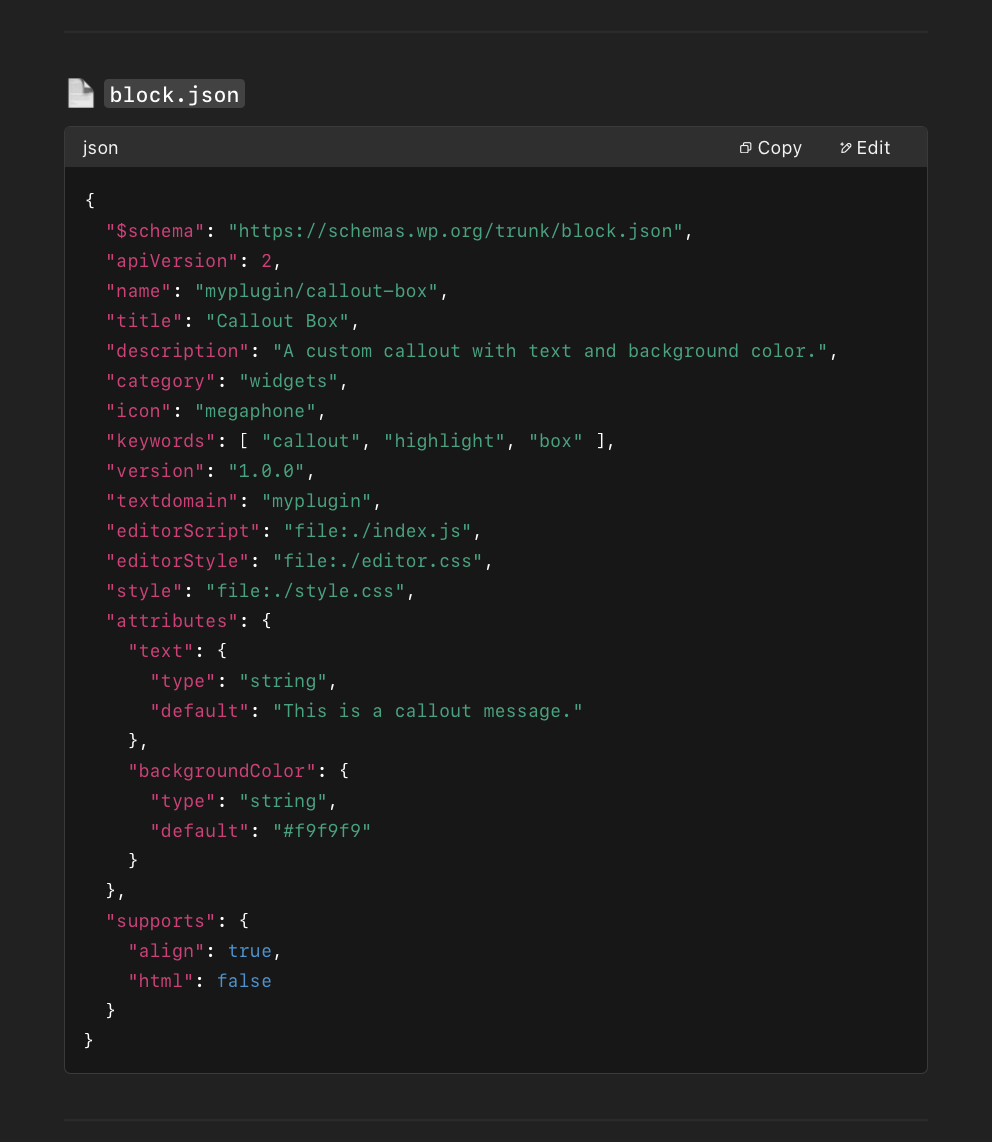
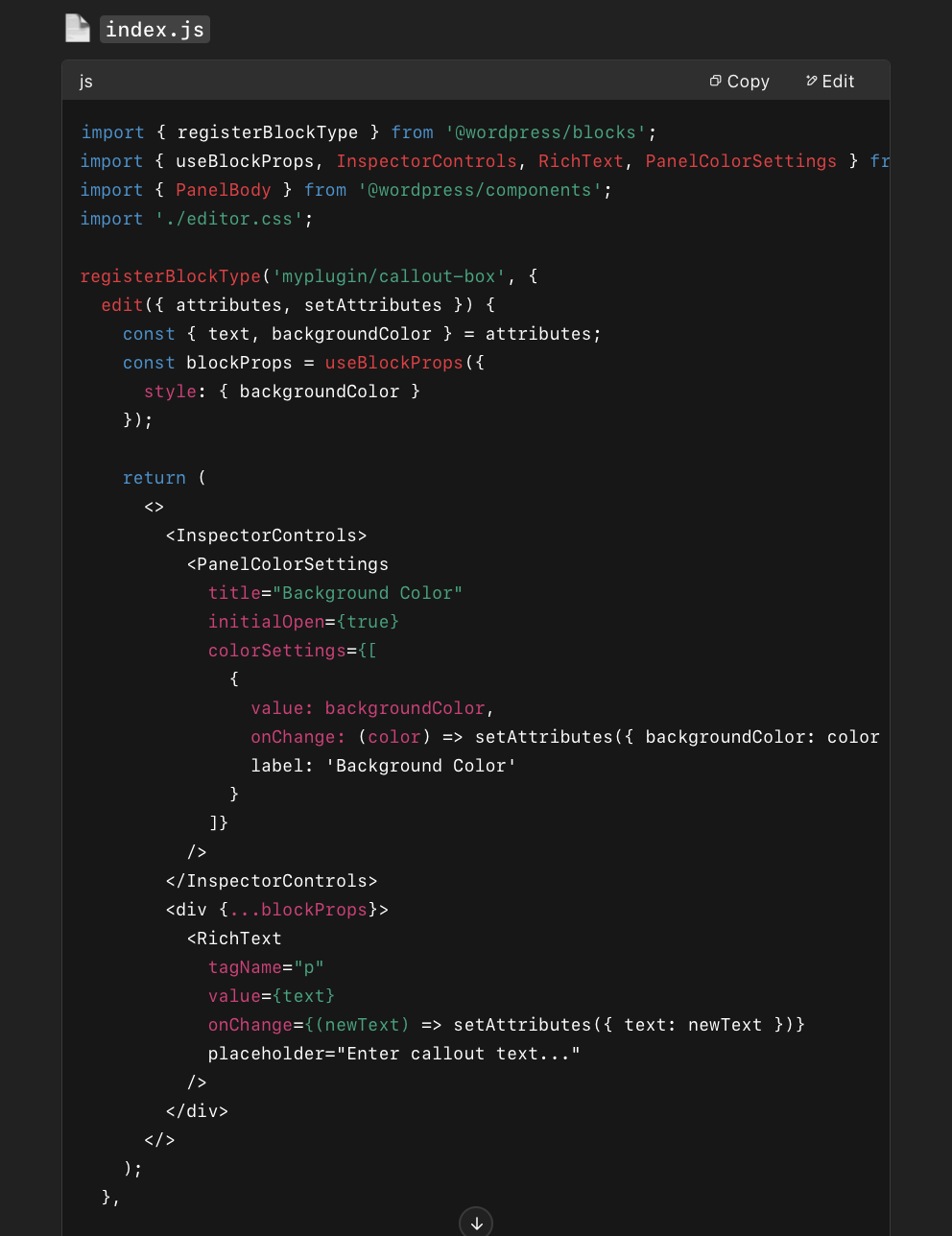
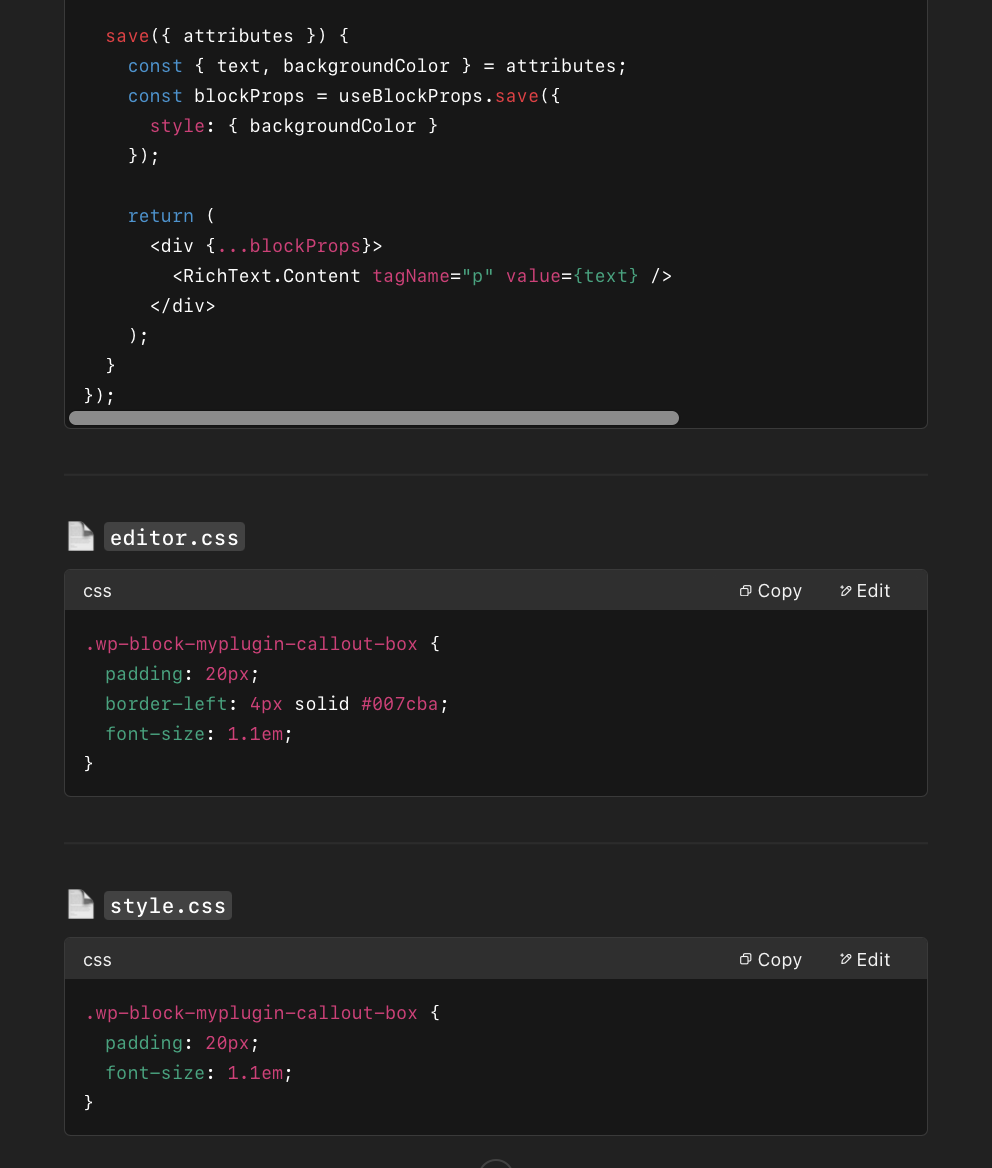
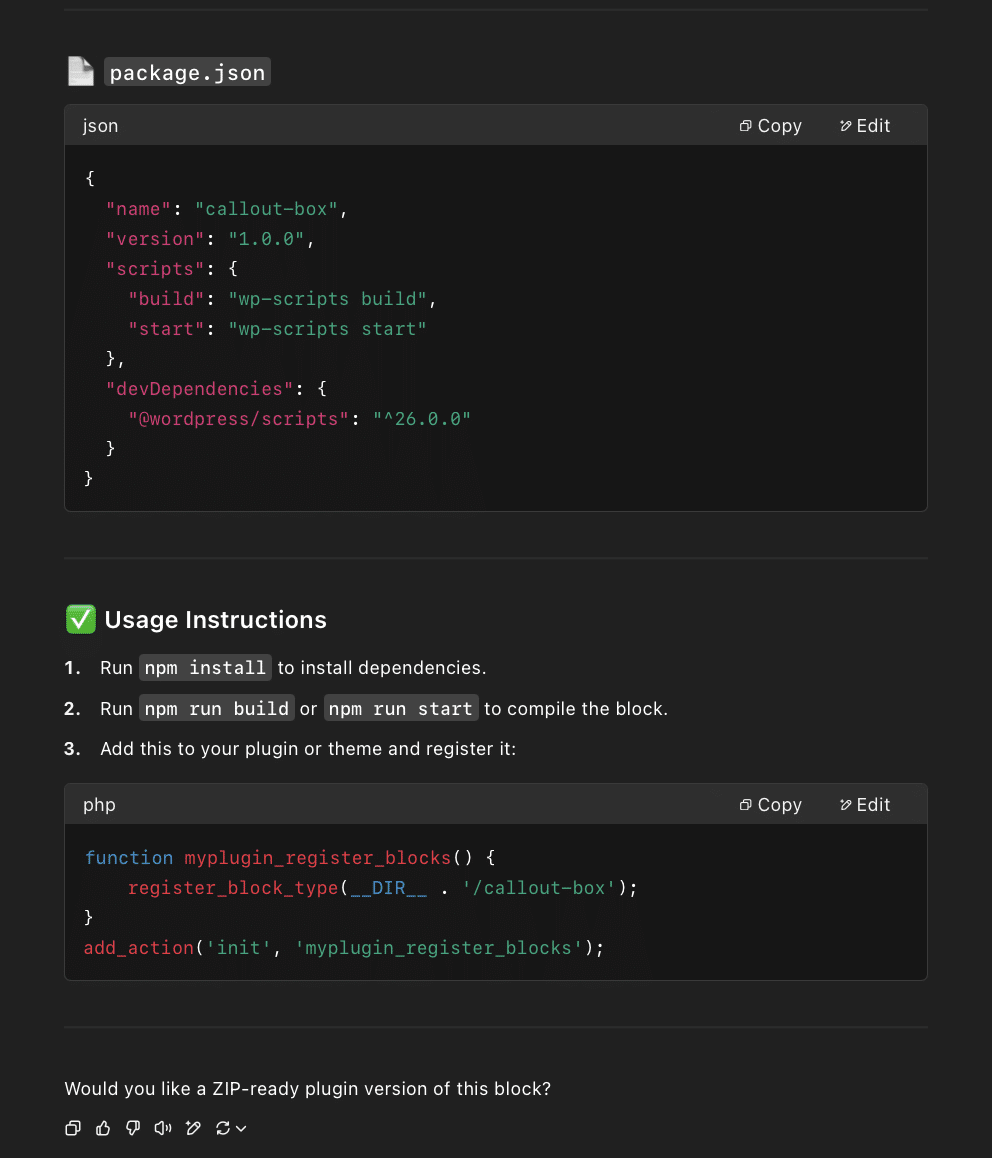
Try the AI Prompts Now
You don’t need to spend hours bouncing between Reddit threads, prompt marketplaces, or yet another half-baked “AI prompt generator” site.
We’ve already done the hard part: tested, refined, and compiled the best AI prompts for WordPress developers and freelancers. Here’s what’s inside:
- AI prompts for headless WordPress & REST API
- AI prompts for plugin development prompts
- AI prompts for functions & snippets
- AI prompts for performance optimization
- AI prompts for security reinforcement
- AI prompts for WooCommerce customizations
- AI prompts for admin UI customization
- AI prompts for database and query optimization
- AI prompts for Gutenberg and block editor
- AI prompts for testing and debugging
- AI prompts for troubleshooting WordPress
- AI prompts for ACF + Gutenberg integration
So, if you’re tired of the noise and want something that works, grab the full PDF with 100+ of the best AI prompt examples across 10+ categories.
👉 Download the Ultimate AI Prompts for WordPress
Frequently Asked Questions About AI Prompts
We used ChatGPT to generate the prompts in this guide, but you can also try Claude, Gemini, DeepSeek, Llama 3, or open-source models like Falcon. Some tools perform better with code. Others are great at explaining or reviewing it.
Start by thinking about tasks you repeat often, like creating custom post types, fixing login issues, or customizing WooCommerce. Then, turn those tasks into questions or requests. Our downloadable PDF has 200+ ready-to-use AI prompt ideas across 10+ categories.
Yes, if you write clear, specific prompts. AI can speed up repetitive tasks, suggest code, fix bugs, optimize queries, and even help with WooCommerce customization. But the key is knowing how to ask the right questions.
